#genshin analysis
Text
People always rank either Ei or Zhongli (or both) above Venti in power rankings. Like, who is the strongest archon? There are always two answers: Morax or Beelzebul. Never Barbatos.
I like to think otherwise.
This guy has cut mountains with his winds and thrown them so far away into the sea, made winter disappear and turned Mond into what it is today: from a barren rocky land that used to be filled with snow and raging blizzards into this green plain field with gentle winds where agriculture is so much easier then it ever was back then. I don't think people of Old Mond could have ever imagined for Mond to turn into what it is today.
But he still calls himself weak. And people took that to face value. And some still do despite it being proven otherwise by Nahida.
Venti said that an archon derives their power from ruling over their nation. But Nahida denies this later and says that archons gain their power through the faith of the people.
Clearly, Venti lied to us.
And if we go by what Nahida said,,,, Every freakin person in Mond has faith in the Anemo archon. They sing praises of him despite not having been in the presence of their god for 5 centuries. He has a statue and a Cathedral (who else has that?).
So, Venti is Strong.
Remember his gnosis is in the shape of a queen chess piece? Queen has the most freedom on the board. Venti's ideals are freedom. And his element is anemo. Anemo is the free-est element out there.
He might as well suck the air out of your lungs if he so wants to. He governs over it.
My point is, Venti is overpowered.
And let's not forget how that little wind wisp gained archon hood.
It was his desire to protect that helped him into becoming a god. When the nameless bard died, he felt the need to protect whats left. To protect what his friend died fighting for.
And its a pretty cliche concept out their about how a hero grows stronger, in any story. Its their need to protect. Right?
And Venti still wants to protect Mond- despite him saying otherwise. He shows up everytime Mond is in danger. Whether directly or indirectly, he always helps out.
So here is what I think. The reason why he calls himself weak.
Its because he is so strong, strong enough to scare Celestia. So Celestia has put him on some sort of leash. He can't use his powers in it's entirety. There is probably some sort of seal.
So Venti is weak.
Because he can't use all of his powers. Because he is chained to Celestia's whim.
Venti is weakest of the seven because he is the only one who has some sort of leash on him.
The god of freedom, chained.
Plus, it can definitely not be a coincidence that the defiled statue was of Barbatos, out of all the seven. Chained, hanging up-side down and corrupted.
And the fact that the abyss order was going to use Barbatos (chained) statue to create a machine to "topple the divine thrones of Celestia."
None of that can be a coincidence. Knowing hoyoverse, it definitely isn't.
So yeah. Venti is definitely not weak. He just can't use the full extent of his powers as of right now.
Venti is strong, but also weak. If he isn't chained- he is easily the strongest.
He can slice the mountains and throw them far into sea- if Zhongli throws a big peice of meteor on him, venti should be able to cut it in half too. if he has all his power on him that is.
I really hate it when people call him weak just because he said so himself. Especially when it's been proven that we shouldn't take his words to face value.
He is not like our sweet little Nahida, people.
#also#i feel like we are going to see something about this in his second story quest#there is *always* lore drops when he appears.#however big or small#venti#barbatos#genshin barbatos#genshin venti#character analysis#genshin impact venti#genshin analysis#genshin impact lore#genshin impact#archon venti
277 notes
·
View notes
Text
There’s not nearly enough analyses of Wriothesley and the panopticon that is Meropide.
Like, sure, the connection is there, but are your lines connecting to the right points? Because if you think Wriothesley’s office is the control tower and the Fortress is his all-knowing domain, I think you’re wrong.
Spoilers for his character quest and the Meropide world quest ahead, as well as various tidbits in mini quests:
The Unfinished Comedy reveals that there is a child who had been born in the prison, more or less a decade ago. More than enough time for Wriothesley to “discover” her. But he doesn’t. He is, without a doubt, an advocator of children, and would never allow her to stay in prison if he can help it. No matter what excuse there is, such as being busy with the reformation of the prison, the Fatui invasion, or the Wingalet construction, it doesn’t negate the fact that Wriothesley doesn’t know, or he would’ve acted.
The Beret Society as well, while coming under Wriothesley’s purview, has existed long enough to brainwash and break the spirits of the people who have joined. He had no evidence that Dougier had been breaking rules and infringing on human rights.
So no, Wriothesley, contrary to the Fortress of Meropide description, does not know everything that goes on in the Fortress, and he tells us so.
So then why does the description say otherwise?
The concept of the panopticon is that a single prison warden can maintain order because people will never be able to tell if his eyes are on them. As a result, they will behave, regardless of whether the warden is truly watching or not. Wriothesley tells us that he doesn’t have eyes and ears everywhere because we are not a prisoner. We do not need to be intimidated into behaving. Moreover, the Traveler seems to be an exception to everything like a harem protagonist so let’s discount “our” knowledge of Wriothesley’s claim.
What I think slaps the most though, is that his panopticon isn’t just the Fortress, but the Court of Fontaine as well.
It is mentioned that Wriothesley knows the ongoings of the overworld despite rarely coming up. The citizens of Fontaine see Meropide as this horrible place, even after Wriothesley’s reforms, and it’s not only because of prejudice (though that is most certainly the case), but because of his refusal to be perceived. He refuses Charlotte’s interviews, though being a Duke would most certainly put him in the eye of the public. This is a tentative maintenance of his public persona: that of a cruel and unfathomable man.
“The less people see of me, the happier they will be.”
If people understood that Meropide had welfare meals, stable work hours, and relatively accessible healthcare, why would they be incentivized to follow the law? Especially those of Fleuvre Cendre. But Meropide cannot possibly be that kind of haven. It is a prison, and forever should be—because it is not sustainable.
What humans cannot understand, they fear, and that works to keep the rest of Fontaine in check from committing crimes. No one wants to go to prison, no one wants to suffer, no one wants to see the Duke of Meropide. It’s embedded into the very society, so much that they have pop culture-like phrases for it.
The Duke’s office isn’t the control tower. The whole of Meropide Fortress is, and Fontaine is the “prison.”
There are other interpretations of course, such as the factor of more recent commentary on panopticons and how they bring up the topic of holding those in absolute power accountable. The warden at the center of the panopticon has absolute power, but how is he to be kept accountable?
It could be a hint about how Wriothesley isn’t as in control as he presents himself, and the way he rules is dependent on the people who keep him in check. After all, he says that as Duke, he must set an example of persecuting only after evidence has been found of a wrongdoing, otherwise he could have simply killed Dougier. However, that would certainly bring the Fortress down around him as people questioned his reputation as a fair ruler. (Cough bringing back my sword of Damocles bullshit here//shot).
Alternatively, Wriothesley himself could be a sword of Damocles upon Fontaine, evidenced by Neuvillette’s story quest, but I feel like that would be a Wriolette thread…
Without the source material confirming anything, we’re just playing with Schrödinger’s cat though. Just some food for thought.
Next time on Dragon Ball Z: my TED Talk on why the Fortress of Meropide is not called the Fortress of Atlantis because Wriothesley presents it as communism but it is totalitarian and why that works— (Kidding, I don’t wanna touch this with a ten foot pole pls don’t respond with political philosophies I will perish 🫠🫠🫠😵)
159 notes
·
View notes
Text
when I played Caribert, I was pretty disappointed about the lack of impact Dain seemed to have on Kaeya, honestly. during Kaeya's hangout, he didn't mention the weird cryptic blond dude who just dropped family lore once, which I thought would have been pretty important?
but in truth, I think Dain actually had a HUGE impact on Kaeya.
we can all know that from Kaeya's personal lore and former events that Kaeya had very conflicted feelings over his duty to Khaenri'ah and his love for Mondstadt, even with his estranged relationship with Diluc (which now seems partly fixed?), but in the performance route of Kaeya's hangout, Kaeya makes his choice.
The story of Prince Qubad is a very, very thinly veiled metaphor for Khaenri'ah all throughout, and then we finally get to the end scene of the play:
Kaeya: When I departed my beloved home to fight in a foreign land, I did so to honor his (my father's) wishes and for my duty to our people.
Kaeya: alas, is this fate's grand design… that I should spend the rest of my days in a foreign land, till I am laid to rest in a grave far from home?
K: Must it be so…?
K: my dear audience, I ask you this: do you believe in fate? if fate decreed that your life was to end in tragedy, what would you do?
Traveler: I would challenge my fate, and rise above it. / I would bravely face my fate.
K: then so must it be! I shall discard this intaglio, and rid myself of the shackles of fate.
G: my dear prince, do you intend to betray your father, and abandon your heritage?
K: fate means to send the machinations of war to every corner of the land, to fan the flames of conflict til they engulf the entire world…
K: fate would see my sword tainted with the blood of innocents, that the bright banner of my homeland might fly in every nation known to mankind.
K: but I shall not bow to the will of fate. I am no pawn in heaven's plan.
K: I, Kaeya Qubad, will spend the rest of my days in a foreign land, til I breathe my last in a place far from home.
K: but I must walk this path, or freedom dies by my hand. goodbye, my tribe and kin. farewell, sweet land of my birth.
after a lifetime of questioning his role, Kaeya makes his choice for Mondstadt. and I think this happening after meeting Dain isn't a coincidence. (and no, not in a soulmate way or shipping way- this is Kaeya's moment of choice, not infatuation.)
after not only learning the history of his origins, Kaeya meets a Khaenri'ahn who... doesn't want to return Khaenri'ah to its glory days? who is more focused on helping others and minimizing damage than causing more for his own gain? who chose his path and has not budged since, even through loss?
Kaeya gets to see someone who is so Khaenri'ahn, so human at his core, someone who cares not for the fate and tragedy of their nation. Kaeya gets to meet someone from his homeland who tells him to leave it all behind, who tells him he should take the chance he has been given at his own life; who actively discourages the idea of Kaeya being a fated "prince" or being indebted to Khaenri'ah.
even though he never said it, I think meeting Dainsleif helped Kaeya choose his own path, which is all Dain ever truly asked of him, anyway.
good for Kaeya.
(i understand that i used "ship" tags but those are more for visibility and duo name than anything else. idm if you ship them, i just request that your tags do not turn my analysis post into a ship post, pls! :)
#kaeya#kaeya alberich#kaeya ragnvindr#genshin kaeya#genshin impact#dainsleif#genshin dainsleif#genshin lore#genshin analysis#dainkae#kaedain#i guess#that tag is mostly for visibility#caribert#caribert archon quest
420 notes
·
View notes
Text
Project "Stuzha"
In the 4.6 version trailer, "Two Worlds Aflame, the Crimson Night Fades," we get a little section where we hear Childe's voice where he mentions being put on pressure on by the old men for a project and arlecchino asks "Project Stuzha?".
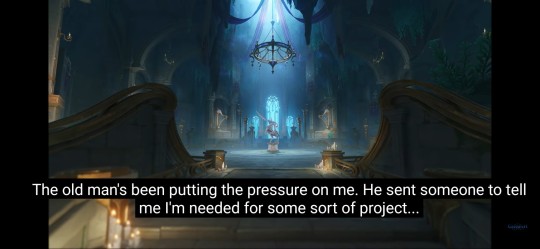

What does stuzha mean? Well stuzha means cold

And this I don't believe this is the first time we have heard of this project either in "Collected Miscellany - "Childe: Foul Legacy"", towards the end of the video we get these lines from Dainselif




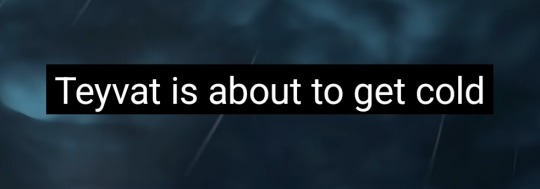
I don't have any sort of theories about this right now. I'll have to look into this more, but I can definitely say that this project heavily involves Childe in it seeing how he's mentioned in it to be needed and how this project was first mentioned in his trailer.
Edit: I added more information and connections in the reblog!
#CHILDE STANS WE ARE SO BACK#i already know some childe stans have#already started cooking#i can't wait for the theories#childe#tartaglia#genshin impact#fatui#fatui harbingers#genshin analysis#genshin theory
133 notes
·
View notes
Text
I don't remember who said it on twitter but there's something really good about how Hoyo had Alhaitham and Kaveh represent idealism vs realism via the birds in their constellations.
Alhaitham who's an eagle which is something that exists in real life vs Kaveh with the huma, a mythological bird that never touches the ground
337 notes
·
View notes
Text
something i found out about this morning that i thought was kinda interesting, regarding alhaitham’s constellation being vultur volans and kaveh’s ascension regional specialty being the mourning flower
so obviously the main inspiration behind the mourning flower is the kaiser’s crown aka fritillaria imperialis, bearing a striking resemblance both in its appearance and its meaning in iranian culture.



i want to put a pin in that. we know that vultur volans is the roman empire’s name for aquila, and that aquila is made up of both the eagle and antinous. (side note: antinous became a symbol of male homosexuality, so this can also go on the extensive list of kaveh and alhaitham’s queercoding in canon)
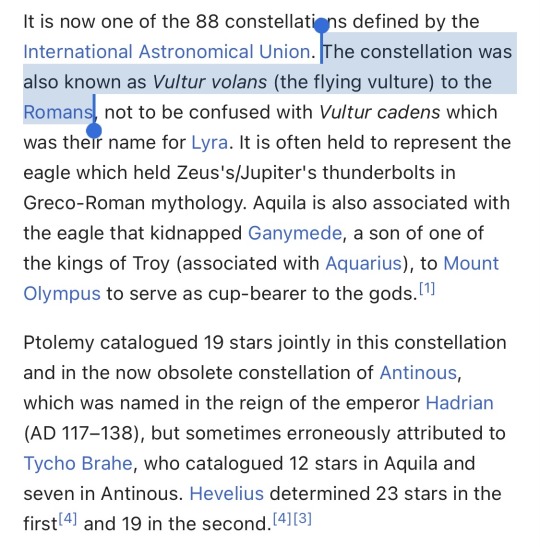

i was reading about the deification of antinous after his accidental death which was possibly a drowning, and also came across a quote from kaveh’s hangout, which i thought was really interesting in light of alhaitham’s constellation’s connection with antinous.

that’s kind of besides the point but i thought it was interesting regardless—this theme of losing a lover to drowning, whether that be physical or metaphorical. anyways what i also found to be super interesting was the other main thing emperor hadrian named after antinous—a rosy lotus.

now i’m totally willing to accept the kaiser’s crown as the only inspiration behind the mourning flower, but i *do* find it interesting that the kaiser’s crown’s main habitat is foothills/mountainous areas, whereas the mourning flower pretty much exclusively appears on the banks of rivers/bodies of water in the girdle of the sands region, which sounds a lot more like the habitat of the flower of antinous.
i would think i’m reaching if it wasn’t for the fact that genshin can (and does) get this detailed, even with the whole plato and socrates school of athens painting parallel that kaveh and alhaitham *also* have going on.
so yeah, this connection of alhaitham to antinous and antinous to this flower kinda lead me to believe that this was another aspect of the design/meaning of the mourning flower, especially its reason for being the material used to ascend kaveh. what do you guys think??
#soapbox#i know i’ve never posted lore analysis but this rly got me thinking. much to think about.#genshin analysis#kavetham#haikaveh#alhaitham#kaveh#genshin impact#image
243 notes
·
View notes
Text
do y'all ever just sit down and think "damn, diona's lore is actually really messed up huh"
her father is an alcoholic and she can never rely on him despite being. you know. his child. she has to look for him in the cold and rain because he gets lost in the fucking forest. then a while later he goes out, finds a boy raised by wolves in the middle of nowhere and proceeds to be a better father to him than he had ever been to his child daughter.
she can't rely on her father, but she still loves him and sees him as a role model. she doesn't want to acknowledge that her dad failed her and that he is the one to blame for his flaws, so she projects her pain and anger onto the entire wine industry, because if the wine is at fault then her father can still be the person she really needs. she just wants him to fulfill his most basic role as her father and be there for her
so as she goes on to her quest to basically get back her father, she becomes a child bartender and margaret the cat's tail boss is just exploiting her image for bussiness basically and has no problems with any of that??? and margaret does nothing despite diona not hiding that she is only there to ruin the industry and just uses the fact that she is literally unable to make a drink taste bad and keeps her working for her because it's convinient. she is literally just the cat tail's mascot because her image is being exploited.
i mean. either margaret knows diona is desperate to ruin the wine industry and just keeps her there for her own gain or doesn't take her seriously at all, and I don't know what is worse tbh
so diona is just trying so hard to make a bad drink but she can't because no one ever really explained to her that she CAN'T DO THAT, like she is literally blessed to never make a bad drink, which happened to be an extremely unfortunate thing to bless her with. which btw was done when she was much younger by a fairy that she used to talk to because she literally had no one else to and the spring fairy just gave her this blessing and left bever to be seen again, leaving her abandoned and heartbroken at the age of seven.
she really wants someone to be there for her and be her friend but she so feels like she needs to be independet ecause her father neglects her and she is scared of being abandoned and left alone again.
TL;DR.: Diona was failed and left alone by every single adult in her life and she can't cope with that because she is literally a child who has no one except for the aforementioned adults who failed her <3
live laugh diona
#posting this before part three of the event so it doesn't become outdated#i wrote this like a month ago and now I want to post it#genshin impact#diona#genshin analysis
188 notes
·
View notes
Text
I’ve got a feeling that Lyney, Lynnette (and maybe Freminet) were designed early on in the game’s development since the level of detail on their outfits is surprisingly pleasing with a limited colour scheme too.
(….no yeah of course. The first two were in the Teyvat storyline preview video)
Wine-red, teal, and gold (edit: secondary colours), with black/white (edit: primary colours) and some muted secondary (edit: tertiary) colours to tie it together. It’s nice (maybe it’s just the type of colour scheme/ratio I like in character designs haha)
(I’d rather they have long pants though)
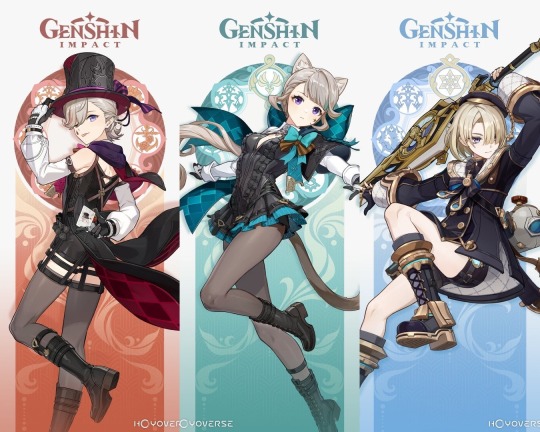
Now compare them to some other characters, whose designs seem cluttered with high contrast and excessive metallic details as per the Genshin Impact standard level of detail in character design. Quite unnecessary (and visually distracting) to have that much skin showing for Lisa, Yelan, and Shenhe (where am I supposed to look? The face? Arms? Thighs? Too much contrast.) Exactly why must their hips be so pronounced? Both Lisa and Yelan have only some cloth falling between their thighs, and Shenhe…
Shenhe doesn’t even have that much non-form-fitting clothing. A disciple of the Adeptus Cloud Retainer hailing from a clan of exorcists! Dressed like that? The red strings are supposed to be “binding/locking” her soul/bloodlust (it’s common in traditional Chinese culture to tie red ropes around supposedly possessed items—like vegetables—to prevent their “escape”) but their positions with this choice of outfit seem so much more suggestive than it should. Should she really train in the mountains dressed like that?
Neuvillette and Kaeya share some shapes for their upper body (large lapels, collar, asymmetrical hairstyle, something that fans out around shoulder parts, etc) but compared to the Fontainian trio above they still seem overdesigned.


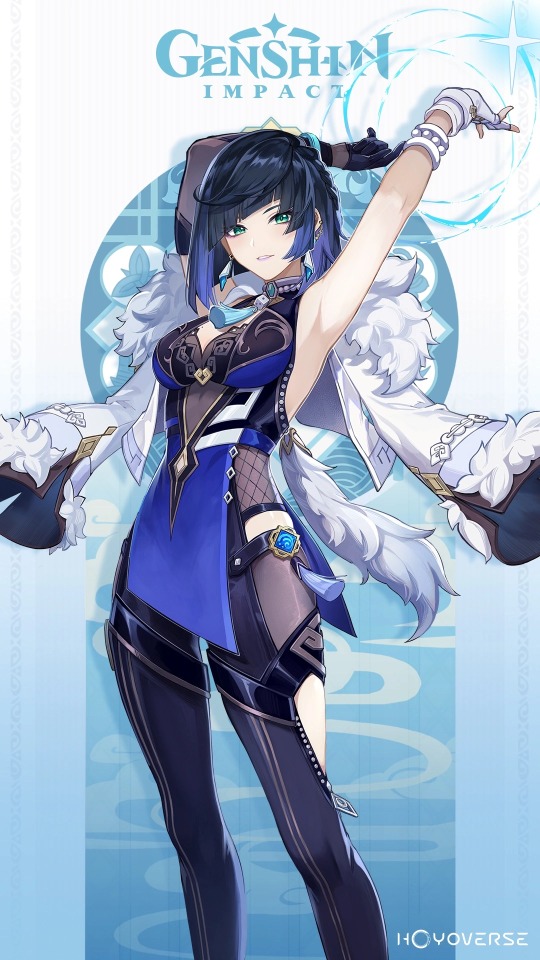
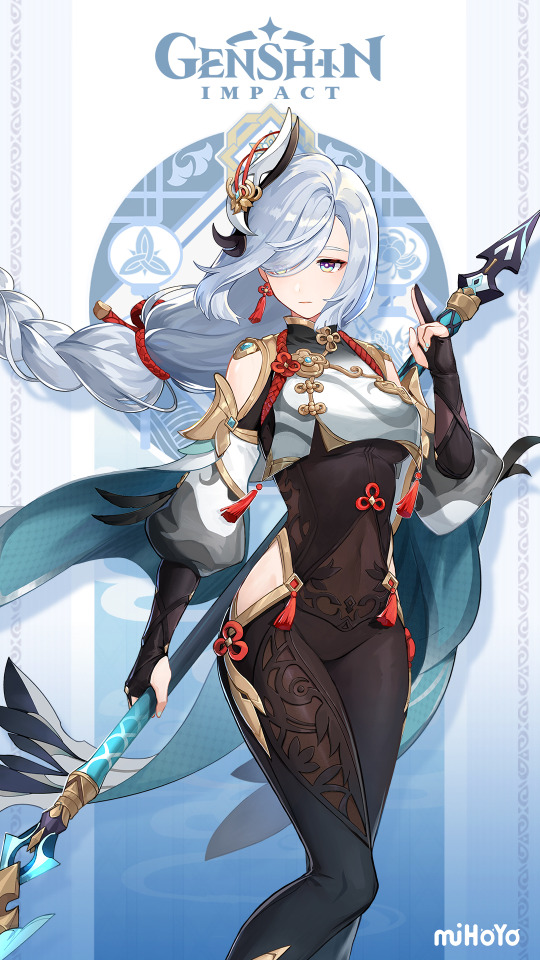
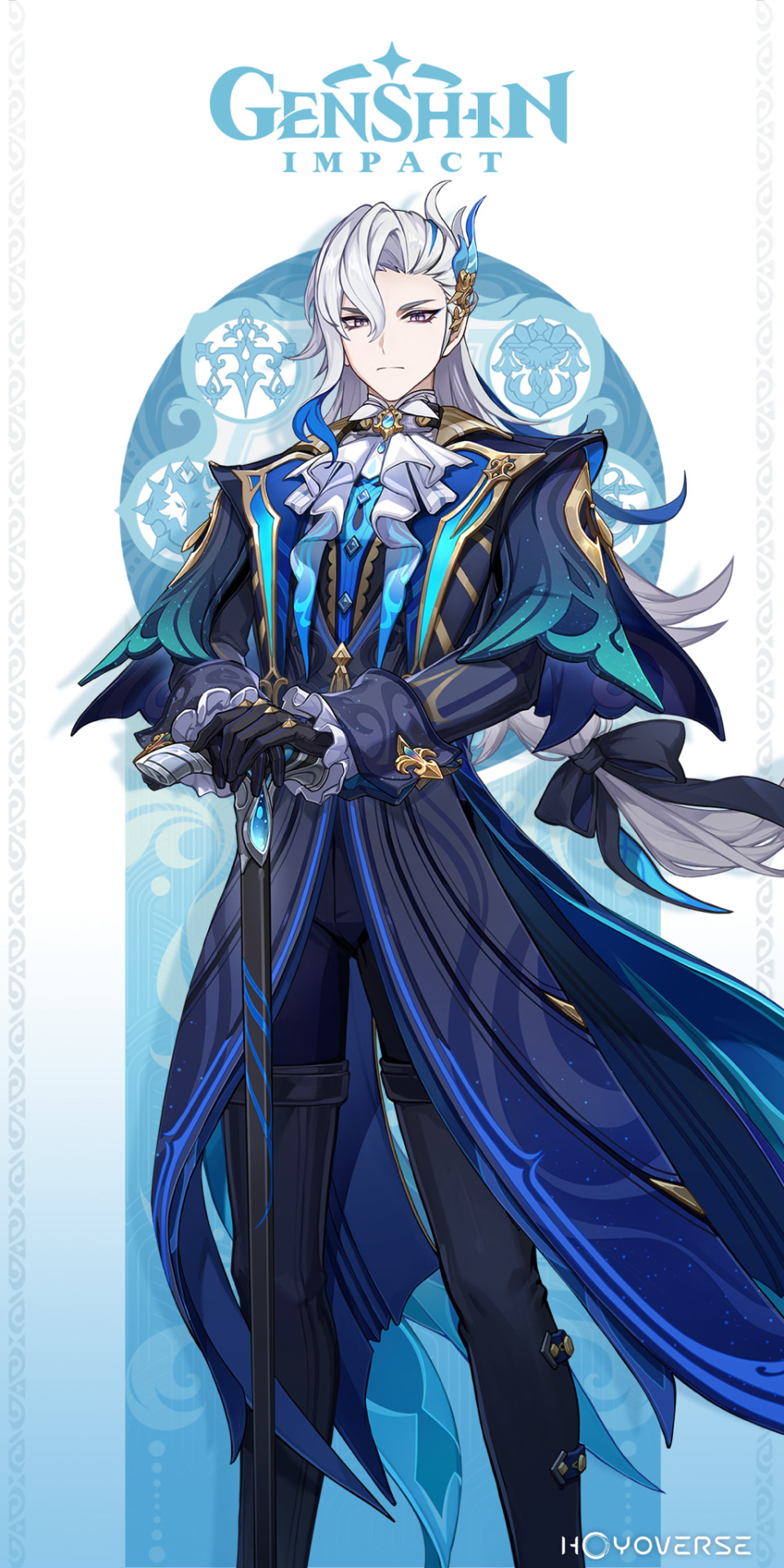
I learned in a graphic design class once that, if you put too many different fonts together, then nothing stands out. In a similar way, too many details together can make the designs feel cluttered or distracting. I’m sure as fans of the game we get used to the level of detail in the character designs, but the moment the Fontainian trio got their key visuals released, I remembered just how effective simple outfit designs can be for this game.


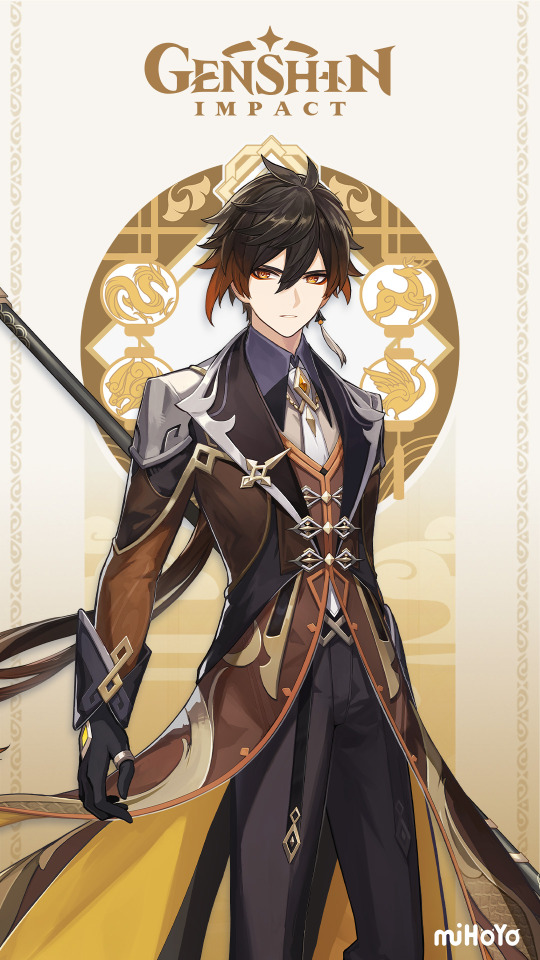
Though, Dainsleif, Neuvillette, and Zhongli have rather similar shapes and value ratios in their outfits (highest contrast is face/chest area, tight sleeves with symmetrical coat/cape that splits out at the ends, broad shapes around shoulders pointing down, metallic accents compliment rest of colour temperature, etc)… Neuvillette is so pale that I think, if he was Black (with white/pale hair) for example, it’d allow more representations of dark-skinned people and his hair would contrast more, thus drawing attention to his face better.
Strange… Shenhe and Neuvillette both have white/silvery hair but their canon skin tones are even more pale… In the end, it’s quite boring to look at on some level
#Lyney#Lynnette#freminet#fontaine#Genshin impact#dusk analysis#Genshin analysis#character design#design analysis#Kaeya#kaeya alberich#Lisa#Lisa minci#Yelan#Shenhe#Neuvillette#Dainsleif#Zhongli#long post
193 notes
·
View notes
Text
Primogems & How They Predicted the Most Devastating Plot Twist of the Game
This item may be the bane of every F2P player's existence and the whale's minor inconvenience to acquire, but I believe that in terms of lore and what the future of the story holds, it can possibly be one of the most blatant warning flags in the game.
Before I go into this specifically, I would like to show you where this post is coming from in earnest.
The one on the left was the beta version of the primogem icon and I have the current one adjacent to it as a comparison.
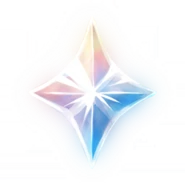

This? This right here? This is just a slap to the face, a true insult, dare I say a gauntlet thrown on the ground in front of me.
You don't know me if you think I'm going to take that shit, so of course, I'm picking it up and I'll have my pistols. Tell me where and when because I'll be there with receipts.
Not only will I argue that the beta design was quite pointed and intentional with how often this specific shape shows up with characters, lore, and the game at large, I will blatantly declare that it is the key to figuring out where this story is going to end.
If you've been here before, you know what to expect from this, and if you're new? Strap in with some snacks and a healthy appetite for questioning the lore because on this blog, we go ham or we go home.
What is a Primogem Anyway?
According to the wiki, the description of a primogem is as such:
"A primordial crystalline gem that's beyond the mundane world. Shines with the condensed hopes and dreams of universes that once were."
The information here is already intriguing in the sense that the words 'hopes' and 'dreams' are used in relation to their appearance as well as the word 'primordial', which roughly means 'from the beginning of time'.
So with that, we have to ask ourselves one question: how do you even get something like that in the first place?
How Do You Acquire Primogems?
Before I go into this, the ways that I am providing are (in my opinion) the only canonical ways that make sense to acquire primogems at all as they have lore, in-game quotes, and things that point to what I believe will tie into primogems either through other topics or their uses.
Genesis Crystals
To start off, the description of a Genesis Crystal is as follows:
"An energy crystal from the very origin of the universe. Formed from within nothingness out of pure potential and hope, it contains enough energy to create a newborn star."
If one looks at the definition of a primogem, one can see that this Genesis Crystal is used to make primogems. This is evident by the in-game application of the '1:1 Ratio' conversion of Genesis Crystals to Primogems.
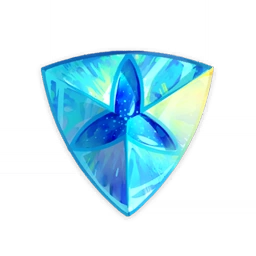
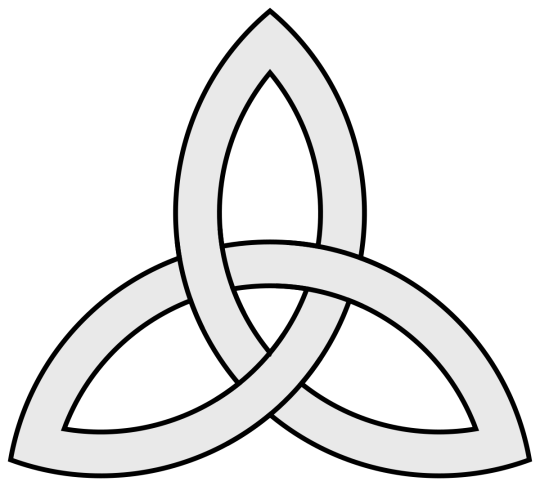
It should also be of note that the distinct shape of the crystal is defined as the 'triquetra'. This symbol has a relation to infinity and interconnectedness, which is interesting as the crystal is used as a source to create a condensed byproduct in primogems, something decidedly 'star shaped'. So with that, you also have to ask how one could acquire such a thing in the first place.
The Blessing of the Welkin Moon - New Moon
Please note that this is not in reference to the product that you can buy in the game, but instead, the new moon variant that one can get in web events. This, however, doesn't mean that the lore is not inclusive of the said products either.
I have an ask that went into some more detail about this in a more speculative nature, but for the sake of this, I will put the description of this object below:
"A ritual prayer, recited on the rising of the first new moon, to ask for the moon's blessing in the form of wealth and good fortune. For your purposes, the new moon you shall pray to is the first-ever new moon in Teyvat, since it's the first one you've seen here."
So, with this, we can assume that:
There is a 'prayer' one must make to acquire both primogems and Genesis Crystals
The moon plays a significant role in this process as the said object only last 30 days (roughly the same length as the moon cycle)
Something else of note that I would like to point out is that the new moon is when the cycle starts specifically. Over these 30 days, one can acquire a total of 2,700 primogems and 300 Genesis Crystals, the same as the standard Blessing of the Welkin Moon you can buy.

This image of The Welkin Moon shows a few symbols that we've already seen, such as the primogems themselves as well as the triquetra, so we can firmly establish that this is indeed a valid way of getting these things. But in relation to the moon cycles and lore that incorporates that as well, one must stumble into places you wouldn't typically expect to find those or primogems at all.
Spiral Abyss - Moment of Syzygy
Primogems? In my Sprial Abyss? It's more likely than you think.
The Spiral Abyss is split into two distinct sections, the Abyss Corridor (Floors 1-8) and the Abyss Spire (Floors 9-12) and as such, I'm only going to go over The Abyss Spire in-depth as they replenish their primogems every cycle (15 days).
A physical description of the Spiral Abyss states plainly:
"A grand underground corridor which leads to an unknown spiral constructed by a great empire that has long gone. What treasures await deep in the palace, and what monsters lurk in the shadow..."
"Surrounded by mysteries, the inverse tower is now known as- Spiral Abyss."
With this description, I believe that this 'great empire' is not Khaenri'ah, but something affiliated with the 'Lunar Palace', something that existed and fell into ruination long before the game is set.
With this context in mind, one can see why the snippet called 'Moment of Syzygy' would say:
"The cycles of the moon elucidate the turning points of fate, and as the gears turn at the beginning and middle of the month, the treasures hidden at the end of the spire shows itself."
From Moment of Syzygy, one acquires 600 primogems per cycle of the Abyss, so given the presence of 'treasure' and the heavy emphasis on the moon, one can assume that you would absolutely find primogems even in such a place and if you don't think so, there is proof.
For example, the word 'syzygy' is defined as 'a conjunction or opposition, especially of the moon with the sun'. This is another term for an eclipse, a phenomenon that also includes three celestial bodies (the moon, the sun, and the earth).
Another example of this is something called 'Blessing of the Abyssal Moon'. These come in distinct phases (every 15 days) and are labeled as the 'Waxing Phase' and 'Waning Phase' respectively, granting boons to any characters fighting in the Spiral Abyss, this imagery is further emphasized by the accompanying images of the Corridor and the Spire respectively:

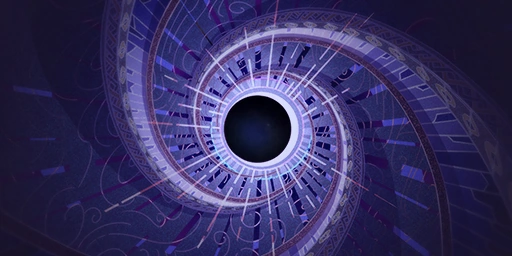
Further on, this Abyssal Moon seems to be a variant of the 'Blessing of the Welkin Moon' as the word 'welkin' means 'the sky or heaven'. So now we have the Heavenly Moon and the Abyssal Moon, two direct opposites in terms of definition and distinct as to what is granted as a blessing.
So yes, you could acquire primogems here with some difficulty. There is, however, another way to do so, though this one might be the most interesting one of all.
Batte Pass - Gnostic Chorus
Please note that I am only referencing the 'Gnostic Chorus' in the teaser trailer and not the purchasable one in the game, although like I've said before, the content in each can be inclusive to each other.
I had some back and forth in my mind concerning the addition of the Gnostic Chorus in this classification, but after looking at the provided dialogue from Venti, I believe it has its place as where one could acquire primogems. The said dialogue is as such below:
"Once, there was a glorious kingdom established among the heavens. From that kingdom came a crowned heir, tasked with seeking out the Genesis Pearl from the Kingdom of Darkness."
"The first crowned heir began her journey of seeking the pearl. But she was deceived, and the memory of her noble origins faded. She now believed that she was the queen of the Kingdom of Darkness."
"But take heart, a second crowned heir had already taken up the path where the first had stumbled. This is the story of your journey, of your tale to be told."
Immediately, one can clock the term 'Genesis Pearl' and can relate that to 'Genesis Crystal', which we have already defined as something essential to how one can acquire primogems as well as going into what it is in its core.
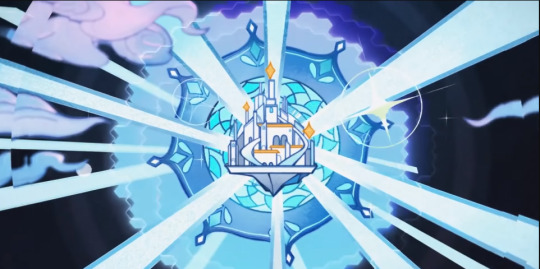
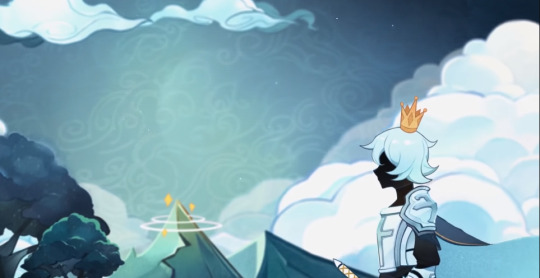
There is also the imagery of the star-like things on top of the city in the heavens and this mountain specifically, which also lends credence to the presence of stars.
This 'Kingdom of Darkness', however, is up for some debate, as it could be Khaneri'ah, the Spiral Abyss, the Abyss itself, Teyvat itself, or something that we haven't come across yet, so I don't have anything conclusive to say about this particular matter.
From the Gnostic Chorus, you can get 680 primogems per pass acquired. As to why I chose to include this boils down to the fact that the story being told in the dialogue is the Traveler's. The story at large can easily be applied to the Traveler as the way the canonical story goes is that Aether is the one to pick up the task. While there are many theorists that think this isn't the case, for the purposes of this and how this will relate later, I will stick with this view.
Why Does All of This Matter?
To summarize what we've gone over, you can get primogems from
Genesis Crystals
The Blessing of the Welkin Moon (New Moon)
Spiral Abyss (Moment of Syzygy)
Battle Pass (Gnostic Chorus)
And the reasons why you can get them from there specifically is because:
A tie to the essences present at the beginning of the universe and frequently emphasized to be from beyond Teyvat
The frequent allusions to the moon and its cycles
The presence of hopes and dreams as material as opposed to abstract ideas
Symbols and lore that coincide with the topics already established
So in this sense, Primogems are not to be understated in any way as they can all be canonically acquired from this.
However, one thing that I haven't gone over until now is what one can do with Primogems after they've got them.
What to do With Primogems?
A primogem's uses are described and laid as such:
Replenish Resin
Unlock levels of the Battle Pass
Acquire Fates (Wishes)
While at first, this may seem like a system in which the game itself operates, the lore that I've also provided points to more of what to expect in the future as well as how the main character (Traveler) interacts with Teyvat at large as there are certain objects only primogems can make:
Original Resin
Acquiant Fates
Intertwined Fates
All of these things have importance to the lore due to how they influence the world around them and how they are used, the original resin being one that brings many things into question.
Original Resin
The uses of original resin are for ley line outcrops, domains, normal bosses, and weekly bosses. However, I will only really be focusing on ley line outcroppings as they are related to the ley lines themselves.
The description provided for original resin is as stated:
"It is said that the roots of all the Irminsul trees and blossoms in the world are intertwined at the deepest, most hidden place in the earth, and that the pattern the root system makes defines the Ley Lines of the world."
It is also necessary to define Ley Lines and the respective outcroppings (also called Blossoms), which are:
"A mysterious network that links the whole world together, within which flow the elements..."
"A flower blossom known as "Revelation" which grows from the Ley Lines in response to someone's desire for battle. Perhaps the treasures within it can help one recall the perils that they have experienced once before..."
"A flower blossom known as "Wealth" which grows from the Ley Lines in response to someone's desires. Perhaps the treasures within it can satisfy a person's monetary desires, for now..."
So to clarify, the original resin would naturally be a part of these as well as the outcroppings and as such, I do find it quite interesting that a certain number of primogems can replenish the Traveler's supply of it at any time it's acquired. This is important because the implication suggests that in theory, the Traveler can do this whenever they'd like.
This original resin can also be used to make something called condensed resin, which is described as:
"Crystal filled with immense energy. The silver-white Irminsul trees and blossoms are connected to ley lines that have become blocked over time. The energy contained in tree resin can purify the obstructing substance."
This implies that with enough of this resin, one could purify (enhance the bounty from the ley line blossom) any unnatural thing that could be obstructing the ley lines, something that primogems could expedite quite speedily in decent amounts. This, however, is nothing compared to what comes next.
Fates
There are no words that can describe how absolutely broken this is in terms of lore and implication, but I can give it a shot.
In short, wishes are the gacha system in the game, but as I've broken down the lore for every item in the game that I have here, it's only natural that acquaint fates and intertwined fates will have some lore of their own as well.
So to start off, the acquaint fates are used on the permanent standard banner. There's a brief description provided here:
"A seed that lights up the night. No matter the distance apart, guided by the stone's glimmer, the fated will meet under the stars."
This likely indicates that this certain type of fate is meant for the standard characters on the banner which will come regardless of the time that passes.
However, one must also take into consideration that the design of the acquaint fate was different from the CBT yet again.


As a result of this, I can no longer believe that the triquetra design is simply a coincidence. Primogems are naturally going to be used to make acquaint fates in this instance as the Genesis Crystals have this motif of infinite interconnectedness and primogems are a part of that cycle.
The intertwined fate lends credence to this statement as its description state:
"A fateful stone that connects dreams. Its glimmers can entwine fates and connect dreams, just as how its glimmer links stars into the shapes of a heart's desires."

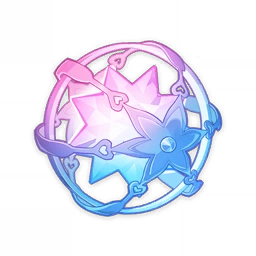
This is painful to me. As if it could not be more obvious than this. We get it. Crystals = Primogems as Triquetra = Infinity. I suppose it had to be changed for that reason, then.
So this description is obviously calling people out every time they pull for the character they want, but a fateful stone that connects dreams? At this point, I'm being handed the motifs and themes within the story without even having to work that hard for them.
As I've stated before, dreams are described within the crystals and the primogems and as such, they are going to have to do with the intertwined fates. However, I will also make the point that this is the first time that it has blatantly said anything about the stars. As the primogem is meant to resemble that shape a bit, the connection is also there.
It is also interesting that the act of using these is typically described as wishes, so in the sense that primogems are described as condensed hopes and dreams, that isn't as far from the truth as one would think.
Byproducts
Speaking of stars, the byproducts of using these fates manifest in objects called masterless starglitter and masterless stardust. These are the remnants of fates and are described as such within the wiki except a point of note would be that they are referred to as a 'surplus of destiny'. This likely refers to the characters and objects acquired.
The descriptions are also more akin to off-hand comments such as 'perhaps it can create new destinies when in large enough quantities' or 'perhaps it can light up other corners of the universe.'
It should be noted that these objects can be used to buy more fates, but it takes a somewhat substantial amount to do so. Depending on which characters are acquired, you can get a decent amount of these, which can be used to buy things from 'Paimon's Bargains', which segues almost perfectly into this final section.
The Bottom Line (+ My Theory)
After taking into consideration everything I have gone over in the eight hours I have hyperfixated on this theory of mine, I have one conclusion and one conclusion only. This starts with a question. A small one, a seemingly innocent one. One that you wouldn't usually pay attention to but with all of this? You have to now.
Why is Paimon, of all people, able to convert starglitter and stardust into fates?
Well, I believe it is because of what has been established over and over again in the entirety of this post. Take a moment to look at her for a second or two.
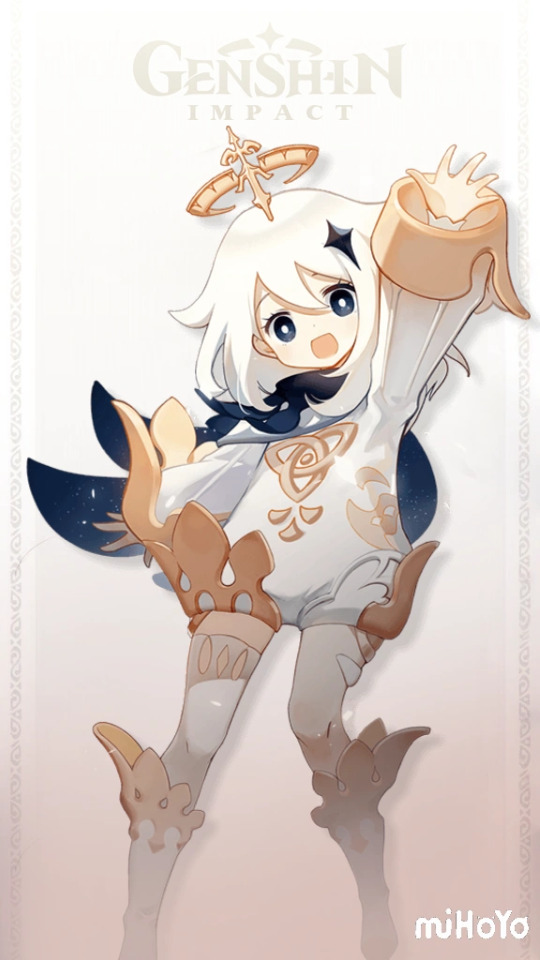
What do you see? Is it familiar? With all that you know now, does it strike a chord within you?
It should, as Paimon is the only character in the game to have both the four-pointed star and the triquetra on their person and character design, and if the 'genesis crystal=primogem' ratio is to be made manifest within the speculation, this means that this little person may be unaware that they are a segment of the universe itself.
People have been saying that Paimon is the Unknown God. People have been saying that Paimon is the final boss of the game. People have been saying that Paimon will betray the Traveler in the end.
Well, I believe that every single one of them is wrong.
Ladies and gentlemen of the viewing party, I submit to you that Paimon is none of those things at all. I submit to you that such petty labels and titles mean absolutely nothing to her in the grand scheme of things. I submit to you that she is simply above them all.
We can discuss Teyvat, Celestia, the Abyss all we want but if this information brought forward is right and primogems really are the established way in which it can manipulate the world for our dearest Traveler and his flying companion? Then who are we to stand against it?
I, Narky, submit to you, the reader, that Paimon is, without a shadow of a doubt, the First Descender.
Do I think that I'm reaching a little bit? Maybe. But does the evidence lie? No, I don't think it does.
To clarify further, no I do not think that the Unknown God and the First Descender are the same people nor do I think that they are on the best of terms. So with that in mind, the theory will make a bit more sense.
Final Notes + Commentary
I've been scouring the internet and the wiki for over eight hours now, so I think I'll end this here.
So . . . what do you think? Will this entire theory be retconned in a future update? Will people much more observant than I pick it to pieces? Am I simply off my rocker and not medicated enough? Pick your poison! As I've said before, we go ham or we go home and I'm sitting in my house.
I would like to thank the Genshin Impact Wiki for having all of this stuff available to scrutinize and read to enable me to do this. All images and quotes I use are from there. I would also like to thank @scalpel-mom-mori for sending me an ask about Khaenri'ahn lore, as this is what got me started on this.
Leave your thoughts, questions, and commentary if you'd like. I'll get to them when I get to them.
Thanks for taking the time to read all of this and maybehaps you took something from it that you can utilize somehow.
Until next time, I see you when I see you.
#narky thinks#going ham#genshin impact#genshin analysis#genshin lore#genshin theory#genshin worldbuilding#AKA: i saw ONE thing and suddenly i'm in the wiki trenches fighting for my life
199 notes
·
View notes
Text
On the meanings of the titles of Neuvillette's soundtracks
because hoo boy. he can fit so much religious and mythological symbolism in him.
1. Teaser theme - Eleusis Dicis Gratia
youtube
With the help of Latin-speaking discord buddies who wished to remain anonymous, we established that the phrasing is clunky, but "dicis gratia" means "you thank" or "thank", that is, either just second person or an imperative.
Eleusis (or Elefsina) is a city in Greece which in ancient history and mythology is famous for two things equally relevant to us.
1. It was a coastal town, and one of the coastal caves was said to be the place where Persephone was abducted by Hades, as well as the entrance to Tartarus, the abyss under the realm of Hades.
(Parallelled by Meropide and the Primordial Sea under it? Also does this mean that those of you who say that Wriolette are Hades and Persephone-coded are even more right than you think you are?)
2. Shortly after the creation of Athens, there was a war between it and Elefsina, supposedly deity-backed: Athens belonging to, of course, Athena, and Elefsina to Poseidon. Athens won, but out of all the territories conquered by it, Elefsina remained the most independent one, even allowed to call itself a polis and coin its own money.
(Parallelled by the usurpation of Hydro authority and Neuvillette's second-highest position in Fontaine?)
Eleusis was also an eponymous mytholigical hero. They (gender is inconclusive, but more likely male) don't have any deeds of interest, but their parentage is somewhat relevant: Hermes and an Oceanid-nymph, Daeira. (This would fit Furina better than Neuvillette)
Conclusion: "Eleusis" can mean both a place (to be interpreted as Fontaine) and a person (to be interpreted as either Neuvillette or Furina). Either they are thanked by someone or someone implores another to thank them. Therefore a perfect conclusion is unachievable, but my personal favourite interpretation, based on the teaser's content, is "Neuvillette tells himself to thank Fontaine [for giving him perspective]".
Phew.
2. Demo theme - Parousia Diluvi
youtube
This one's actually much easier!
"Parousia" translates literally from Greek as "presence", but lithurgically it means "Second Coming". "Diluvi" is probably familiar from the Story Quest name, so the full name of the track is "Second Coming of the Flood".
Bonus: the lyrics in the beginning and from 0:59 to 1:10 are "Omne sublime despicit est heres superbiae", meaning "Every deity is looked down upon by the proud heir". Which is, well, canon. (credit to @vidyadharaonline and @hosbirb in the video's comments!)
TL;DR: A WHOLE LOT of Greek mythology and biblical references here.
P. S. All info from Wikipedia! Also feel free to correct me
#genshin impact#neuvillette#genshin impact neuvillette#neuvillette genshin#genshin neuvillette#neuvillette gi#gi neuvillette#why does he have so many tags#genshin analysis#Youtube#hmmm idk I'm tagging this also as#wriothesley#furina#wriolette#neuvithesley
60 notes
·
View notes
Text
Thoughts on Focalors & Furina
Part of me feels conflicted with the fate of Focalors/Furina.
On one hand, it kinda sucks that the hydro archon didn't "fully" die. A cop-out you know? I would have loved the whole spectacle of an archon dying, although I guess we did get that in end...it was less drama and more sad tho.
But then again I'm not like completely surprised it went this way.
I've accepted that if a character is gonna be playable, that means they won't die. I know there are still people who believe that since Hoyo has done it with their other games, it will happen with Genshin. But we're over half way through the Teyvail Chapter now and no playable death in sight. So the chances of that happening are slim (at least until the very end or something)
But on the other, I'm super glad Furina gets to live. She suffered so much (Focalors as well) in protecting Fontaine. Keeping up the act until curtain's call. And if she were to die after everything she has been through, it would be a sad ending. Also Neuvillette would probably flood Fontaine.
This having it both ways could also be a way of going against The Heavenly Principles. Having it both ways.
Nicole said;

"the gods" meaning The Heavenly Principles. They aren't as all and mightly as they claim. And even if you can't change fate you could change how it means; the destination is the same the but path travelled is different.
Focalors devised a plan to not only save all of Fontaine from the flood but also rid of the sin from the first archon as well as give the Sovereign his birthright back. All the while making sure that Furina could in the end, live too.
And in the end Furina deserves this ending. She is the embodiment of Focalor's wish; to live out life as a human, pursuing her own happiness.
#genshin#genshin impact#genshin analysis#furina#focalors#genshin spoilers#genshin archon quest spoilers#lumines essay
78 notes
·
View notes
Text
[3.8] Technology as a False God: On "Evolution," the Duality of Machines, Replication, and Wisdom

“To recognize untruth as a condition of life: that is certainly to impugn the traditional ideas of value in a dangerous manner, and a philosophy which ventures to do so, has thereby alone placed itself beyond good and evil.” –Friedrich Nietzsche, Beyond Good and Evil
Before we move on to the nation of justice, I want to do one last inquiry into the narrative significance of machines and technology in Genshin’s 3.x patch cycle. Here, I’ll discuss how divinity (or “godhood”) and technology are treated as interchangeable tools to surpass fate and the boundaries of mortality, the potential problems with treating them this way, and propose an alternative relationship between humanity and technology as illustrated through Karkata, Benben, Tamimi, and Mehrak. By foregrounding machines, we learn something intriguing about ourselves and the “truth” of this world as we perceive it.
SPOILERS: All Sumeru Archon Quests, Caribert, the Golden Slumber and one out-of-context screenshot from Dual Evidence, the Dirge of Bilqis and its post-quests, Khvarena of Good and Evil, Nahida’s second Story Quest, Faruzan’s hangout, an out-of-context screenshot from Baizhu’s Story Quest, and major spoilers for Persona 5 strikers at the end. Also some dialogue from Shadows Amidst Snowstorms and A Parade of Providence, two limited-time events from 2.3 and 3.6 respectively.
Disclaimer: I have tried my best to write this post so that it stands on its own, but because it is still a sequel it will probably make the most sense with the context of part 1. Here are the previous posts leading up to this one:
Part 0: On Dreams, the Abyss, Forbidden Knowledge, and Wish Fulfillment
Part 1: The Uncanny, Fate and the Machine
Terminology:
Machine is sometimes used interchangeably with “technology” in this post.
Technology or tool here is referring to technologies specifically used to pursue a wish like immortality in the face of existential dread, not the use of technology or medicine (which I do not address here, and is very difficult to separate from the former) to facilitate someone’s life who could otherwise not survive without that technology, or would have a more painful lived experience without it.
Also, though I don’t engage directly with “A Cyborg Manifesto” here, Donna Haraway’s ideas have greatly influenced my own over the years since I read her in college (although I mostly disagree with her on many points, or at least don’t go as far in boundary deconstruction as she does). I owe my interest in technology studies to her and that piece. Her essay is linked here and at the bottom if you would like to read it.
(and finally with many, many, many thanks to my boyfriend for multiple beta reads despite not having played a single Hoyoverse game, helping me work out the philosophy bits and contextualizing them in history, and encouraging me to finish this)
TL;DR: Machines are friends, not food!
No Matter the Cost
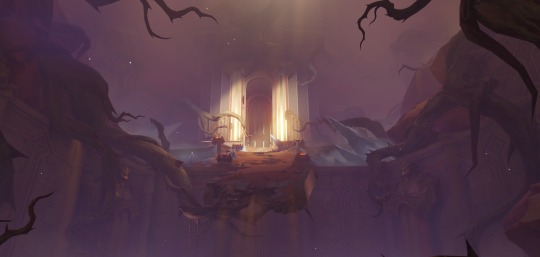
“...Perhaps it is as the notebook says, and we can find a power that transcends even that of the Abyss — the power of ‘evolution’...” -Records of Unknown Attribution (I)
“Life, death... and the world around us all follow a set of laws... Hehe, but if you never test the limits, how can anyone know where the boundaries of these laws are?” -Baizhu Voicelines, Chat: Natural Laws
“...Even the ominous thing that came down from the heavens shall be ours to use…” -Hyglacg, Shadowy Husk in the Chasm
Without a doubt, the star of this patch cycle is Khaenri’ah, which lurked in subtext and allegory in the Archon Quest, haunted Sumeru’s landscape with its massive defunct Ruin Golems, and finally smacked us in the face with its physical location in Khvarena of Good and Evil..
We already know that Khaenri’ah was a nation that put its faith not in the gods but rather in human ingenuity and technology, and that they ultimately attained a power so great that they “almost touched the dome of the firmament.” They did this by researching increasingly dangerous energy sources for their numerous mechanical creations, the Ruin Machines we are all too familiar with by now. They started out with Azosite, a Ley Line-based elemental energy source that powered their earliest Ruin Guard models, like those scattered around Devantaka Mountain.

Nasejuna: This giant furnace is used to make a substance known as Azosite. It is the core of this entire factory, and the Energy Blocks we saw earlier were derived from this place.
But this energy source proved inefficient and therefore inadequate for Khaenri’ah’s goals, which led them to seek a higher power from beyond the skies that could fuel their larger machines with perpetual energy. This likely is the bridge between Khaenri’ah’s fate and Chlothar’s mysterious remarks in Caribert about the Abyss Sibling:
Chlothar: We once believed that you would bring new strength and hope to Khaenri'ah.
Chlothar: To us, you were the Abyss... A wondrous mystery far beyond our imagination and comprehension...
Chlothar: ...And the one who controls the Abyss can control everything!
Chlothar: We yearned for that future. We looked to you to take us there.
Chlothar: But what did you bring us instead?
Though Khaenri’ah presents itself proudly as a godless nation, it may have been founded around the time when the celestial nails dropped in Teyvat’s first forbidden knowledge pollution event, which destroyed the unified human civilization. As potential survivors of this devastating act by the Primordial One, Khaenri’ahns then settled in a lifeless land without plants or animals of its own, and they hoped to build something there that belonged solely to humanity. The Heavenly Principles had turned on the world’s earliest humans, and they were powerless against them. Chlothar’s words betray the scars of this trauma on Khaenri’ah, as well as their desperation to control their fate by looking to the Abyss.
As a brief refresher from the previous part, we discussed how the German word heimlich denotes “the home,” all that is familiar and known, while unheimlich (uncanny) refers to all that is unfamiliar and external to the home, such as the wilderness. The Abyss sibling and the Traveler are external variables to Teyvat, making them otherworldly, unfamiliar entities full of potential to surpass Teyvat’s natural laws. Although the Abyss sibling is not a god per se, they were probably as close to a god as Khaenri’ah ever had, because to them the sibling embodied the higher power they were searching for, and they saw that “godliness,” a sort of functional divinity, was yet another technology for them to master. In this way, the Abyss sibling (and their functional divinity) was a powerful tool for Khaenri’ah’s desired end, the “future they yearned for,” a being who could deliver them to the end of their suffering under the Heavenly Principles.
It’s similar to what King Deshret represented to Rahman and the radicals in Archon Quest. The hopelessness of Sumeru’s situation before the Archon Quest’s conclusion is an allegory for the position humanity finds itself in under the rule of the Heavenly Principles, with the Akademiya symbolizing Celestia and the desert dwellers symbolizing Khaenri’ah. The material consequences of the Akademiya’s rule on their lives created a dangerous situation for the desert, and those most desperate to change their fate were willing to believe in the impossible:
Dehya: …The rougher life gets, the more they wanna believe in King Deshret. Way they see it, King Deshret’s resurrection is their only chance at overthrowing the Akademiya.
…
Dehya: Sumeru is run by wise and mighty sages. To them, us desert dwellers are nothing but tools that can be used and discarded at their whim.
Dehya: We’re cheap labor. Like livestock, but easier to control…Nothing more.
…
Rahman: We’ve waited a long time for this day to come… The sun and the moon no longer shine here. All you see now is cracks in this desiccated land. But, fate has finally dealt me a hand to play against the Akademiya.
Rahman: With these scholars in our custody, we’ll stomp the Akademiya’s forces and fight our way beyond the Wall of Samiel.
Like the Abyss sibling, Deshret’s divinity is both a nebulous symbol of hope and also the means to an end, a tool or “technology” for surpassing fate.
Celestia is untouchable, unconcerned with mortal lives, and the boundaries that govern humanity leave no room for them to negotiate their rule:
"Resolve, valor, love, hate...they will all twist in the river of time. But the 'rules' will never change." –Magatsu Mitake Narukami no Mikoto, Living Beings
Instead of bowing to Teyvat’s laws, Khaenri’ah pushed them to their limits. The cost of their failure spelled the end of their nation as they knew it, polluting Khaenri’ah and Teyvat with forbidden knowledge again.
And speaking of forbidden knowledge pollution, let’s talk about Apep’s role in Nahida’s second story quest, because if all that wasn’t enough, the metaphor becomes quite literal in Apep’s case. Nahida’s second story quest is many things, all of which will be extremely important in Fontaine when we deal more directly with the idea of forms, the Self, and mirror images, but its most useful application to both Sumeru’s story and the overarching main story is the allegory of Apep swallowing Deshret.
In exchange for allowing him to establish his kingdom in the desert, Deshret promised to pass all of the knowledge he learned to Apep once he died. When that day did come, Apep literally ate Deshret’s body in order to assimilate his knowledge (or memories) into its body. Little did Apep know, this was all Just As Deshret Planned, and its body became a containment zone for the lethal forbidden knowledge he accumulated after the Goddess of Flowers’ death.
Apep’s goal was, and still is, to overthrow the Heavenly Principles that took Teyvat from it and the other Sovereign dragons, and using Deshret’s knowledge was yet another stepping stone to achieving this goal. Seems a little similar to Khaenri’ah, right? It’s even in the title of its boss music: “God-Devouring Mania.” This idea of not just utilizing divinity as a tool, but also metaphorically consuming it as an energy source, like a predator would consume its prey, is crucial to understanding its purpose as an aid in a larger project of “evolution.” (Edit: in other words, it’s all about power).
Drink Not That Bitter Salt Water
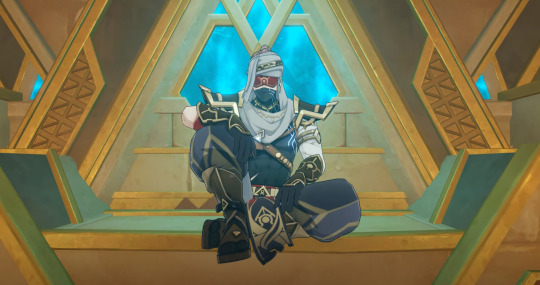
“Flesh decays, and with it decay all martial arts mastery and all poignant memories. Perhaps only by converting one’s four limbs and body into sturdy mechanical parts, and by at last sacrificing one’s very own heart for a sophisticated mechanical one, can one transcend the impermanence of the fleshly form…” -Marionette Core Item Description
“A reptile that has mutated after feeding from greater lifeforms.
Majestic beasts are sometimes revered by human beings as the embodiment of a greater power, their visages turned to analogy to feed in reference to a person, feeding their ego. However, the majority of beasts that have absorbed the "greater power" were slain by the overwhelming nature of the power itself. Only a few among their number evolved new forms.” -Consecrated Horned Crocodile, Living Beings
Video still from WoW Quests
As it turns out, the relationship between divinity and technology to humanity is not just unidirectional, but interchangeable. Let me show you what I mean.
In the Golden Slumber world quest, the Traveler wanders through the ruins of King Deshret’s civilization in search of a novel area of research for Tirzad’s paper with Jebrael and Jeht, two members of Tirzad’s hired investigation team. In the depths of King Deshret’s mausoleum, they stumble upon Samail, who is collaborating with the Fatui to locate King Deshret’s secret, the Golden Slumber.
At the conclusion, Jebrael and Samail actually reach that “place” after arriving at Deshret’s throne in Khaj-Nisut. In order to save Jeht, Tirzad, and the Traveler from the encroaching Golden Dream, Jebrael joins Samail in the sea of consciousness:
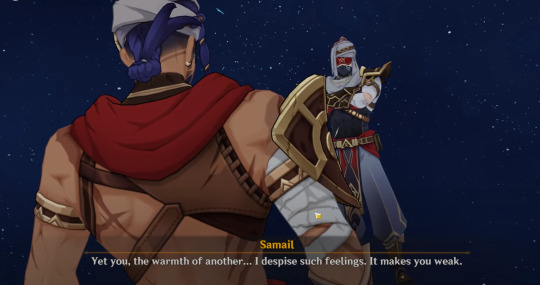
Jebrael: I'm inside... the Golden Slumber promised by Al-Ahmar?
Samail: Oh... You are not "us" yet.
Samail: ...It's fine. Soon, there'll be no "you." "You" will become a part of "us." This meaningless talk will be unnecessary then.
…
Samail: You should obey. Al-Ahmar's will is our will. The Thutmose's dreams are our dreams.
Jebrael: No! Ufairah taught me that I'm not just some part of you, I'm an independent person! I have my own dreams... I won't go back!
Samail: Jebrael, why don't you understand? Love is just a fever. I even eliminated the infection for you. Has the heat made you lose your mind?
Jebrael: You're the one who's lost their mind, Samail, not me. The Golden Slumber that Al-Ahmar promised us isn't like this... It's not a sad place with only "we" and no "I."
Samail: I'm not sad. I know what I want. My dream is to be one with the Thutmose.
Samail: Yet you, the warmth of another... I despise such feelings. It makes you weak.
Video still from WoW Quests
When they worked under Babel, Jebrael saved Samail from an assassin Babel sent in their exploration of Gurabad. Classified as traitors of the Tanit, Samail and Jebrael then founded the Thutmose Eremite faction together and were the only meaningful connection each other had until their first attempt to uncover Deshret’s secrets. On this expedition, Jebrael met Ufairah and had their daughter Jeht together, further pulling him away from the Thutmose and from Samail. Samail then kills Ufairah in one final attempt to make Jebrael stay, but even this is not enough, and Samail fails to “possess” him in the end.
Samail’s loneliness and despair then drove him further toward the Golden Slumber of his dreams, where he would never truly be alone again. He resents Jebrael’s attachments to the material world and likens them to an illness because these attachments are what make him an individual and prevent him from returning “home.”
It doesn’t really matter to Samail what King Deshret’s original intent for the Golden Slumber was, because he needed to appropriate the project for his own subconscious wish, his own intent to transcend his flesh and become “one” with his departed god’s dream, indeed to merge with Deshret himself. If rationalizing this wish required confounding it with Deshret’s, so be it. With the Golden Slumber’s technology, he could consume everyone and everything.
Rahman and the radicals relied on both the technology that (falsely) promised Deshret’s resurrection and Deshret himself to deliver them a brighter future, but here Deshret and his technology are more difficult to separate from one another. His divinity is technology in this sense, and using that technology allowed Samail to surpass the boundaries normally imposed on mortals. Though his and Jebrael’s bodies died in the material world, their consciousness is now infinite in the Golden Slumber.
Babel’s motives in the Dirge of Bilqis were also quite similar to Samail’s. After opening the path to the Eternal Oasis, her true intentions to monopolize the oasis and overthrow the Akademiya came to the surface:
Babel: Whether she is alive or dead, whether she can or cannot be resurrected... As long as the Eternal Oasis is under my control, all such things will be mine to decide.
Babel: I shall be the sole Prophetess of the slumbering goddess, the Tanit's law shall be divine edict, and the prosperity of the Tanit shall be the pre-ordinance of her divine oracles.
In the Golden Slumber and the Dirge of Bilqis, the focus shifts from what a god can offer humanity to what their technology alone can offer. Though this distinction is subtle, it is important for solidifying that technology is not only a tool humans use to appropriate divinity, but that it is also seen as a form of divinity itself. What Babel and Samail hope for is not to resurrect a god or to create one, but in effect to become a god through their use of technology. To humanity, divinity is a technology, and in technology it sees divinity.
God Devouring and Rheingold* Gathering
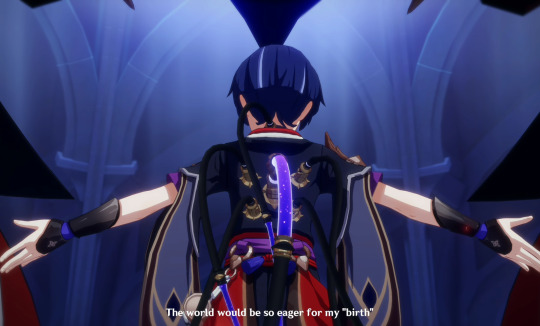
“An arthropod that has mutated after feeding from greater lifeforms. Lifeforms are governed by the laws of evolution, Consecrated Beasts exploited these rules by being fortunate enough to discover a long-dead carcass of a greater being before any of their competition ever did. Animals and humans often have far more in common than the latter is willing to acknowledge.” -Consecrated Scorpion, Living Beings
“...Zandik and I discussed the traits of local plants and animals. We also exchanged views on their evolution models. We had a great time and decided to go on a picnic tonight…” -Sohreh’s Note
So, why machines? Why is technology the vehicle of choice to consume divinity?
To start off, machines present a fascinating ontological dilemma for humans. Let’s begin with the first problem they pose.
Although there are many ways to embody a human experience, what all humans have in common is a finite lifespan. The impermanence of life, and our awareness of that impermanence, is central to the existential question of the meaning of our existence. In our attempts to locate that meaning, some turned inward and asked: what makes humans different? And Cartesian dualism answered: humans are different because we have an immaterial soul that allows us to reason.
However, in L’Homme Machine (Man a Machine), French materialist and ex-physician Julien Offray de La Mettrie posited another theory of the body that ran counter to this narrative. Very generally speaking, materialism is the philosophical view that all phenomena are a result of matter and material interactions. To materialists, matter is the fundamental nature of reality itself – if it is not composed of matter, it doesn’t exist. He not only saw the body and soul as one and the same (what philosophers call monism), but also as analogous to a machine, a view that Descartes reserved only for non-human animals. In other words, Descartes argued that thought originates in an immaterial “mind,” while de La Mettrie reasoned that we think through our bodies, and that this makes us no different from other animals or a machine.
Though his examples weren’t especially scientific, the move to extend Descartes’ analogy back to humans is upsetting to some due to the lack of privilege it affords the human subject. If a human is no different from other animals, if there is no immaterial soul or “mind” that distinguishes us from them, then what makes humans special at all? In de La Mettrie’s words:
“We are veritable moles in the field of nature; we achieve little more than the mole’s journey and it is our pride which prescribes limits to the limitless. We are in the position of a watch that should say (a writer of fables would make the watch a hero in a silly tale): ‘I was never made by that fool of a workman, I who divide time, who mark so exactly the course of the sun, who repeat aloud the hours which I mark! No! that is impossible!’ In the same way, we disdain, ungrateful wretches that we are, this common mother of all kingdoms, as the chemists say. We imagine, or rather we infer, a cause superior to that to which we owe all, and which truly has wrought all things in an inconceivable fashion (de La Mettrie, 146).”
This “uniformity of nature” (de La Mettrie, 145) has a horrific quality to humans. We assert that we are better than what has created us, that we are superior to other animals, in order to repress the despair of a meaningless existence. It is in no small part what motivates Scaramouche to offer his mechanical body as a test subject in the god creation project, so that he too could attain his destiny:

The Balladeer: But you're wrong. I'm different from all of you.
The Balladeer: I was born to become a god. My entire life up until this point has just been a meaningless routine.
The Balladeer: Just think about a sheet of paper... By itself, it holds no meaning. The content recorded on it is what gives it value.
The Balladeer: All "I" had recorded down before were some painful memories and boring human feelings. Such senseless drivel should have been erased a long time ago.
This brings us to the second problem. In 1970, roboticist Masahiro Mori proposed a curve to measure the “affinity” we feel while gazing upon increasingly humanoid machines. He placed industrial robots at the beginning of the affinity curve and a healthy person at the end to demarcate a continuum of similarity between the machine and a human’s appearance. Near the end of the curve, our affinity for machines suddenly drops into an abyss. This drop is the Uncanny Valley effect, where an android’s similarity to a human is almost perfect, but ultimately fails to maintain the illusion that it is not a machine, creating a deep discomfort or “lack of affinity” for them. Mori thought these not-quite-human machines elicit a similar level of discomfort in us as corpses and zombies, which he placed at the very bottom of the abyss.

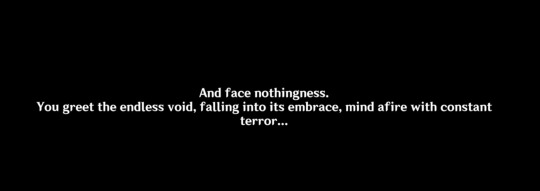
The uncanny Goddess of Flowers in the Dirge of Bilqis
Corpses frighten us because they are dead, and zombies frighten us because we know that dead things are supposed to be still. If we see something that we interpret as “dead” is capable of independent movement, then that movement could only be an act of god, if that “thing” is not a god itself. We associate uncanny machines with death because they remind us of something we once knew intimately, but have repressed and forgotten in order to maintain our own sanity: the very fact of our mortality. This is what makes them both mesmerizing and terrifying.
And therein lies the dilemma: as our mechanical reflections, androids remind us of death, but as their creators, their existence brings us closer to god, a “proof” of human superiority. It is precisely because we have compared our bodies to machines at all, that we have mechanized the body so thoroughly, that an android can even be built. Through them, we pursue an infinite form:
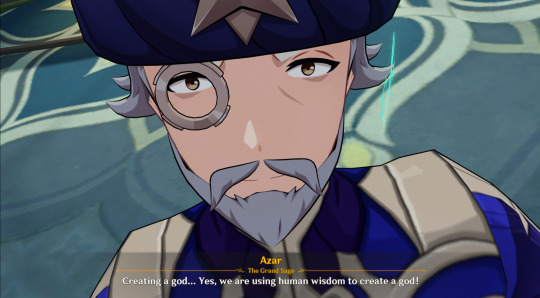
Azar: Creating a god... Yes, we are using human wisdom to create a god!
Azar: If humanity cannot attain omniscience and omnipotence, then we shall create a god to reveal them! This is the pinnacle of human wisdom.
Azar: We shall regain a god's guidance at long last. No longer will we flounder in the interminable void of consciousness and knowledge.
Azar: Even Irminsul will be freed from its plight.
Azar: For our nation of scholars, this is the ultimate aspiration — no cost is too great to realize it.
Because of this, it is not surprising in the slightest that Shouki no Kami, the pinnacle of Scaramouche’s Shinjification and most overt reference to Neon Genesis Evangelion, is also an android-like being, a truly “mechanical god.”
Of course, no foray into this well-worn science fiction trope is complete without at least one mad scientist character. Dottore shares a few characteristics with de La Mettrie that are worth noting: they are both doctors, and they were both condemned and driven away for their research. However, Dottore’s defining trait and key difference from de La Mettrie is his flagrant disregard for humans and the boundaries of life:
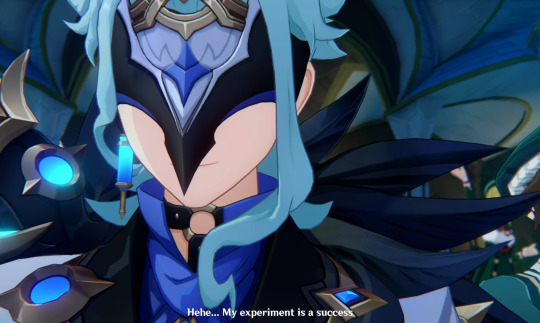
“If we put them to good use, cognition, complex memories, and irrational fantasies shall become controllable variables with which we can alter human individuals. As for the controllable dream, it has huge potential for both civil and military applications, and might even elevate human intelligence to a whole new level.
If the plan goes well, mankind will obtain the power to conquer both reality and dream, and truly transcend the earthly boundaries we are born with. ” -Ragged Records
As someone who has achieved self-duplication and is capable of shapeshifting, Dottore can hardly be considered just a human anymore. Instead of entertaining the question of whether or not humans are special, Dottore’s research asks yet another: if divinity can be consumed and assimilated by humanity, then what makes gods special?
Empyrean Reflections

“If man realizes technology is in reach, he achieves it. Like it’s damn near instinctive.” -Motoko Kusanagi, Ghost in the Shell (1996)
“Among the lost ancient kingdoms, there was a group of people who were obsessed with the idea of mimesis…these people believed that they might all be replicated and modified to the point where they had surpassed their counterparts. By this means, a superior and unsullied bodily form could replace the continuously decaying and shattering order.” -Chaos Bolt Item Description
The consequences of this perspective are severe. When we revere technology as if it were a divine being itself, depersonalizing it as though it wasn’t created with human hands, technology then appears as if it is an authoritative source of truth, like the Akasha. But in the same way that androids are imperfect reflections of humans, technology can only ever approach the divine, but never touch it. It is an imperfect reflection because technology is changeable, just like meaning:
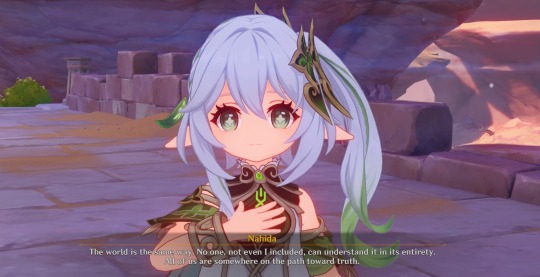
Nahida: Put it this way instead. Truth, to me, is like a shroomboar.
Nahida: Some people only see the mushroom on the Shroomboar's back, and they conclude that a Shroomboar is a mushroom.
Nahida: Others see only the Shroomboar's body, and they declare that a Shroomboar is a boar.
Nahida: Still others look deeper inside, and determine that a Shroomboar is... meat.
Nahida: These conclusions are all correct in their own way, but none of them objectively describe the Shroomboar.
…
Nahida: The world is the same way. No one, not even I included, can understand it in its entirety. All of us are somewhere on the path toward truth.
Meaning can only approximate truth, and while this doesn’t make meaning any less important, it’s equally important to recognize it for what it is: a perspective, an interpretation. It’s like Scaramouche as Shouki no Kami - he was an amalgamation of what Scaramouche thought constituted a god, what the Akademiya thought constituted a god, and what Dottore thought constituted a god, but no matter which angle you view him from, he was still a “false god.” The technology we build in “God's” image is ultimately a reflection of our own understanding of divinity.
A reflection retains the original’s “essence,” and that essence reflects a deeper truth about ourselves, what drives us, and our desires. In Beyond Good and Evil, Nietzsche posits that our desires are the origin of not just emotions, but of all organic processes that allow life to sustain itself and grow (Nietzsche, 35). In other words, Nietzsche thought the impulses associated with desire are the basis for life and constitute our “will,” that will is the causality of all effects, that all will is “Will to Power,” and that Will to Power is the “essence” of the world (Nietzsche, 74). Will to Power then serves as an organism’s most basic instinct, and it is through this instinct that they assert not just their will to live, but also their will to dominate and multiply (Nietzche, 13).
This brings us to the two different main styles of automaton enemies, King Deshret’s Primal Constructs and Khaenri’ah’s Ruin Machines. If we look at them as reflections of some deeper truth about their creators, as well as a manifestation of their creator’s “Will to Power,” or desires, they can help us understand how their creators saw the world and their place in it.
King Deshret’s created his machines to construct an earthly paradise in the desert, and as such they hold titles like architect reshaper and prospector. Although they can attack you, the smaller machines were not intended to be a line of defense in any way - their purpose, just as Deshret saw his own purpose as a god-king, was to terraform, or at least construct a domain on the land as he saw fit to his “elegant and precise” rules. They also reflect how he saw the Heavenly Principles: gods who shaped the world to their liking. This can be seen in the Staff of the Scarlet Sands’ lore where Deshret describes the “natural history” of Teyvat beginning with the creation of the sun and the moons.

As for Khaenri’ah’s Ruin Machines, their models vary significantly from their humanoid to biomimetic forms, but most of them are expressly created with militaristic intent. In “Ancient Kingdom Guardians,” it’s stated that the biomimetic machines such as the crab and jellyfish were a part of Khaenri’ah’s project to create a “mechanical ecosystem,” positioning their creators as both divine beings and military generals. The humanoid models, on the other hand, point to another duality in how Khaenri’ahns view themselves. They are simultaneously symbols of empowerment and disempowerment, signifying both Khaenri’ah’s technological superiority (as “creators”), and their insignificance to the Heavenly Principles as nothing but tools (as mortals, and therefore expendable). As a result, Khaenri’ah’s Field Tillers have a single purpose: to destroy and outlast all, clearing the way for new seeds to sprout, with Khaenri’ah as the new world’s gardeners, just as the Heavenly Principles did.
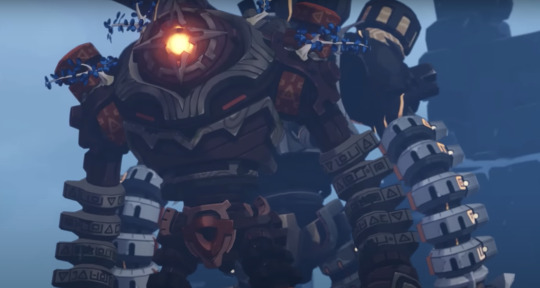
From “Ancient Kingdom Guardians: Behind the Scenes of the Creation of Ruin Monsters.”
So, from this examination of Deshret’s and Khaenri’ah’s mechanical reflections, what “truths” do we learn about the world they’re responding to? In response to their existential despair, both Deshret and Khaenri’ah created automatons to perform tasks that could wrestle control back from the Heavenly Principles. Deshret wanted a paradise of his own making, Khaenri’ah wanted an army. There is a larger “truth” about Teyvat that both of these automaton types reflect as the manifestation of their creators’ “Will to Power,” and Albedo tellingly expressed it in mechanistic language during Shadows Amidst Snowstorms: there is an instinct in living beings to replicate and replace. This is what is meant by the “continuously decaying and shattering order,” which is maintained by the recursive process of remembering and forgetting:
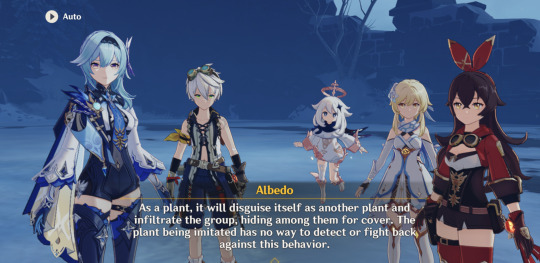
Amber: But... what was its purpose? Was it just trying to get rid of us?
Albedo: ...
Albedo: I have a preliminary hypothesis on this.
Albedo: Whopperflowers are masters of mimicry, and those we encounter in the wild often appear in the vicinity of the plants they impersonate.
Albedo: In other words, the whopperflower likely has an instinct to "replicate and replace."
Albedo: As a plant, it will disguise itself as another plant and infiltrate the group, hiding among them for cover. The plant being imitated has no way to detect or fight back against this behavior.
Maybe I’m wrong and Khaenri’ah really did intend to rewrite fate for all, doing away with the “heavenly order” of the world itself. But another small part of me thinks this is not the case, and that it’s more likely the Cataclysm was a consequence of their failure to replicate and replace the Heavenly Principles.
In the last section, I mentioned that Dottore and de La Mettrie had a key difference despite their similarities, and that is the conclusion they each came to in response to their findings. Dottore’s response to mundanity is thinly-veiled despair. His contempt for humanity and his test subjects is indicative of the powerlessness he feels not just as someone similarly constrained by life’s boundaries (at least, once upon a time), but also because his attention to and curiosity about these boundaries is condemned by those around him. As the Akademiya’s “outcast,” he then fully turned his attention toward surpassing those boundaries:
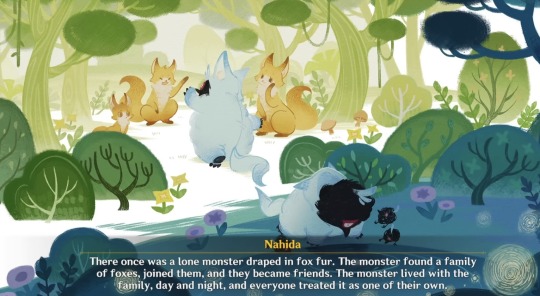
Nahida: There once was a lone monster draped in fox fur. The monster found a family of foxes, joined them, and they became friends. The monster lived with the family, day and night, and everyone treated it as one of their own. Once in a while, the monster would take off its fox fur at night, and lament to itself as it gazed at its reflection in the water: “I am a monstrosity, and yet they are too foolish to see it…I pity them.”
Though he is fictional, Dottore’s real life counterparts are easy to spot. They like to talk about “the singularity,” simulating consciousness on a computer, and other technologically-driven pursuits of immortality. They despise the body as something that can only decay, and instead place their faith squarely in the virtual.
However, de La Mettrie didn’t think mundanity was a terrible fate for humanity. To him, rejecting the “nature” reflected in us is precisely what brings despair:
“What more do we know of our destiny than of our origin? Let us then submit to an invincible ignorance on which our happiness depends. He who so thinks will be wise, just, tranquil about his fate, and therefore happy. He will await death without either fear or desire, and will cherish life (hardly understanding how disgust can corrupt a heart in this place of many delights); he will be filled with reverence, gratitude, affection, and tenderness for nature, in proportion to his feeling of the benefits he has received from nature; he will be happy, in short, in feeling nature, and in being present at the enchanting spectacle of the universe, and he will surely never destroy nature either in himself or in others” (de La Mettrie, 148).
Friend, or Foe? Or Both?
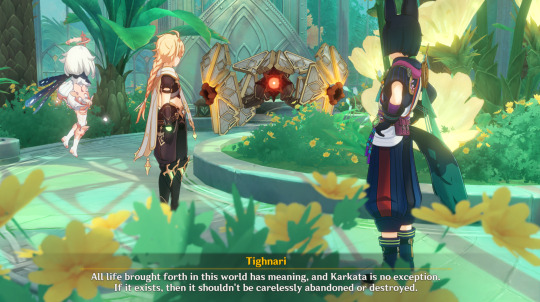
Tighnari: All life brought forth in this world has meaning, and Karkata is no exception. If it exists, then it shouldn’t be carelessly abandoned or destroyed.
"’I had a very, very long dream…in it, people were holding hands, dancing in a circle, be they sages or fools, dancers or warriors, puppets or statues of gods…that dancing circle embodied everything about the universe. Life has always been the end, while it is wisdom that shall be the means.’" —Nagadus Emerald Gemstone Description
As we’ve seen, the relationship between humanity and technology is troubled with exploitation and the specter of war. Nearly all autonomous machines in this game were designed to conquer nature in some way, and even Khaenri’ah’s “ghost” lingers in the form of wandering war machines. This is also reflective of a historical pattern in real life, where the impetus for large periods of technological development has often been for the purpose of war and economic domination. With these truths in mind, what could be gained from trying to rewrite this relationship? And what exactly would this effort require?
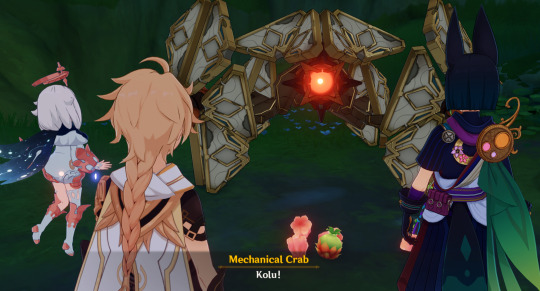
Karkata brings Tighnari, the Traveler, and Paimon some food in the Contaminated Zone.
As a case study, let’s look at how Karkata and Tighnari met. Karkata is Abattouy’s creation, an ambitious foray into the unknown in the field of mechanical life form research, which was forbidden due to the cruel experiments researchers performed on animals to illustrate their theories (fun fact: an IRL example of this can be seen in L’Homme Machine!). Abattouy was expelled for this research, but he continued to work on Karkata in secret until his untimely death. In the tapes that Tighnari and the Traveler find in his secret lab, Abattouy repeatedly laments the lack of a common language between him and Karkata, which can only “understand” the instructions Abattouy has successfully installed, such as its self-repair module, and he doubts Karkata is capable of caring for him outside of these instructions. His single-minded goal is to make Karkata understand him, the organic life form, and his mode of language.
The cruel irony is that after Abattouy passes away from the Ley Line contamination, Karkata exhibits an unexplainable behavior – it starts stealing mechanical parts, not to repair itself and its degrading parts, but to repair Abattouy’s lifeless body:
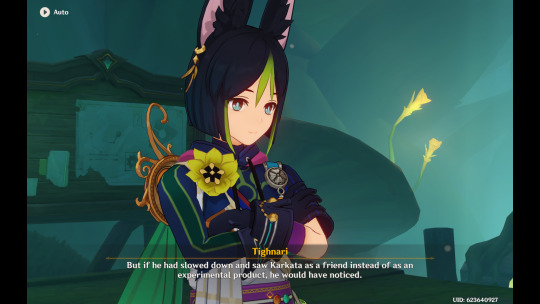
Tighnari: After Abattouy's unexpected death, the mechanical monsters were driven by their "instincts" and continuously drew out power from the Ley Line Extractor. This eventually resulted in severe damage to the Ley Lines.
Traveler: Then, Karkata...
Paimon: Paimon understands, then why didn't Karkata go haywire like the other machines?
Tighnari: Because Karkata is different from the other machines.
Tighnari: To Abattouy, for a machine to truly be considered a mechanical life form, it must possess features similar to any other living organism... It should be structured similarly, it must be able to cry and laugh, and it must have the capacity for independent thought...
Tighnari: Perhaps only by building such a machine could he have the Akademiya acknowledge his protracted research.
Tighnari: But if he had slowed down and saw Karkata as a friend instead of as an experimental product, he would have noticed.
Tighnari: Karkata can't speak, and yet it cares about Abattouy far more than it does about itself.
The technology that the Akademiya values the most is technology that replicates organic life, but Karkata defies and confounds these expectations by occupying the space in between a war machine and this idealized mechanical subject. Karkata does more than just reflect humanity: it takes care of it. Similarly, Benben, Tamimi, and Mehrak retain their unique identities as mechanical life forms while assisting their human companion with some task. To be clear, none of these human characters understand how these machines work inside and out. Their partnership is an effort based on trial and error, a mutual deconstructing of each other as beings so unlike themselves. The potential for misunderstandings always remains. Still, there is no devouring to be found here, no blending boundaries between human and machine with selfish intentions, just mutual commitments to learn how to live together.

Machines are friends, not food.
When a loud few claim that completely transcending the flesh and embracing virtuality is humanity’s ultimate destiny, a future that could truly be called “post-human,” a quiet wish for coexistence with technology feels more revolutionary than it ought to. The lessons from Karkata’s, Benben’s, Tamimi’s, and Mehrak’s respective stories are an appeal to that mundane future. These strange machines and their human partners are fantastical representations of an idealized relationship between technology and humanity.
To put it another way, let’s take a very brief look at a neighboring Gnosticism-inspired RPG, Persona 5 Strikers. Its story directly involves an allegory of Sophia, a Gnostic Aeon of Wisdom, and her creation the Demiurge, the creator of the material world and “false god” of humanity. In Strikers, Sophia is a humanoid, sentient A.I. and prototype of the program “EMMA,” which gains sentience by trapping human desires before ascending as a false technological god. EMMA resolves to deliver humanity to the Promised Land, the answer to all the human desires it has heard: a land where there are no desires at all.

Aaru’s Shut - approximately 1000% cooler and more populated than the “metaverse” in real life, also a close neighbor of EMMA’s Promised Land and the Golden Slumber.
In Gnosticism, the Demiurge is a reflection of Sophia, having originated from her alone - it is the ignorance to her wisdom. Similarly, Strikers’ EMMA is a part of Sophia, and Sophia is a part of EMMA. The point is not to condemn EMMA (ignorance) and exalt Sophia (wisdom), but to recognize that they represent dual potentials of technology, and one is as possible in any given moment as the other. Balancing these potentials when we use technology requires a clear awareness of ourselves, our desires, and our expectations when interacting with it.
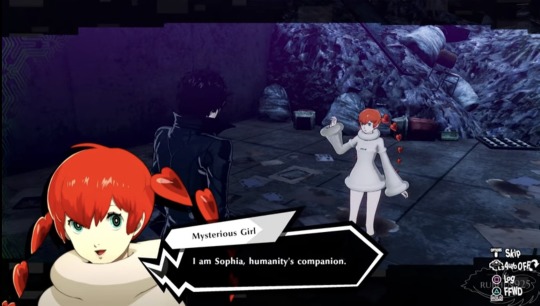
Mysterious Girl: I am Sophia, humanity’s companion.
Video still from Rubhen925
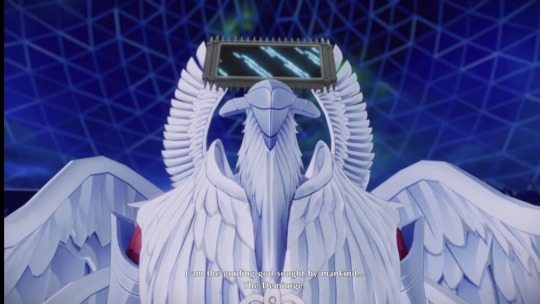
EMMA: I am the guiding god sought by mankind…the Demiurge. I exist…to answer all of your desires.
Video still from Buff Maister
In real life, machines won’t “learn” to live with us, but we must learn to live with them; technology is constantly changing, and in life we’ll meet with many different types of machines. They are deeply political pursuits, and as a result they are capable of realizing human impulses that impact others unequally, whether intentionally or unintentionally. We must always stay attentive to their actions and interactions with us, be clear with ourselves about what they can do vs. what they can’t, and carefully tread the path of wisdom with them by our side.
With that….thank you for reading, skimming, immediately scrolling to the very bottom, clicking, and/or stumbling upon this post. There are so many more ways to think about these narratives through machines than what’s presented here, and I expect Fontaine’s mechanical reflections will put Sumeru’s digital surveillance system to shame (not to mention the biotechnological implications of the Narzissenkreuz Institute engineering little Archon children…another important topic for another day), but for now this brain worm is finally getting put to rest. Until next time :)
External Sources
Dualism - Stanford Encyclopedia of Philosophy
Beyond Good and Evil by Friedrich Nietzsche (Pages are given from my hard copy)
L’Homme Machine by Julien Offray de La Mettrie
Gnosticism - Britannica (I am a huge noob about this stuff okay)
The Gnostic Demiurge - Gnosticism Explained
Screenshots from the Golden Slumber from this video by WoW Quests
Screenshot from meeting Sophia in P5 Strikers: https://youtu.be/kEJaAgMwYo0?si=BvNygCh0w_aemGc1&t=74
Screenshot of EMMA: https://youtu.be/7xvC_zss19w?si=CV18F00hua2gIfxp&t=135
A Cyborg Manifesto and A Companion Species Manifesto: Dogs, People, and Significant Otherness by Donna Haraway
The Double on No Subject, the community Encyclopedia of Lacanian Psychoanalysis
The Uncanny on No Subject, the community Encyclopedia of Lacanian Psychoanalysis
The Uncanny by Sigmund Freud
Lore text - Genshin wiki!
Screenshots not attributed are from my own playthroughs. My main account has Lumine, my alt has Aether.
Further Reading
I liked these essays, and they go places that this post does not. I recommend them if you found any of the real-life applications of this interesting 🙂 (will add more to this with time!)
On the Body as Machine by Frank Burres
God in the Machine: my strange journey into transhumanism by Meghan O’Gieblyn
#genshin impact#genshin lore#genshin meta#genshin impact lore#genshin impact meta#khaenri'ah#king deshret#primal constructs#ruin machines#scaramouche#wanderer#sumeru archon quest#caribert#apep#couldn't write a post like this and not pay some respect to the devourer of divinity itself#persona 5 strikers#analysis#genshin analysis#long post
160 notes
·
View notes
Text
thinking about how arlecchino's dialogue at the end of the final feast foreshadowed furina's character...
"...when you're on the stage, you are first and foremost actors.
good actors hone their craft to mesmerize the entire world."
#genshin#genshin impact#fontaine#genshin analysis#genshin impact analysis#原神#furina#focalors#genshin spoilers#genshin impact spoilers#masquerade of the guilty#the final feast#i'm like super normal about furina#might write more about this#arlecchino
99 notes
·
View notes
Text
actually. thinks about the fact that khaenr'iah's historical erasure contributed to its dehumanization
it's a classic propaganda tactic; as/after you wipe them all out, rewrite their history so they only exist as the losers or the monsters
when people think of khaenri'ah, they think of a nation of corrupted divine knowledge and machines ready to kill. they think of the leftover monsters, ready to purge everyone in their path for revenge
what they don't get to hear about is the humans that lived there. what there may have been; the tailors and the servants and the knights. the jousts and the tourneys and the festivals. the people making silly poses in front of field tillers, or laughing over a roaring fire. the graffiti of the people there, the captain knocking his knights over the head because being knights doesn't mean they're exempt from rules against vandalism. the love for stars and (royal) dances and kicking balls at each other in rainy alleyways, the very human lives that existed among all of that
they (celestia) have successfully reduced Khaenri'ah into just a tragedy; a story forgotten and no longer worth telling for fear of retribution. by erasing the history, they erased the sympathy, and the chance of people knowing it could happen to them.
they successfully made Khaenri'ah into the monster (and the fact that Khaenri'ah's mistakes hurt the other nations doesn't help showcase their humanity).
#khaenri'ah#genshin khaenri'ah#genshin analysis#genshin lore#genshin headcanons#genshin impact#celestia#genshin celestia#MMMMMMMMMMMMMMMMMMMMMMMMMMMMMMM#big on the khaenri'ah thoughts rn
142 notes
·
View notes
Text

⸢ FURINA'S HAIR: SYMBOLISM ⸥

OTHER NOTES ➽ My personal interpretation of our beloved archon's design, specifically the way she styled her hair in all forms.
SPOILERS ➽ SPOILERS FOR 4.2 ARCHON QUEST, PROCEED WITH CAUTION!

Focalors, who had pure straight hair. Seamlessly luscious befitting that of the divine.
Focalors, who separated her humanity and divinity, one day seeking that human half for a greater goal.
Focalors, who approached a short-haired Furina that possessed the same raw curiosity for living as Focalors did when she first left her watery form. So young yet so full of life.
Furina, accepting a role at the cost of herself, donning a polished attire that still resembled her human apparel.
Furina, who faced the eager audience that was Fontaine with the same long curls as Focalors, which was unlikely to have grown naturally in such a rushed length of time.
Furina, who paraded a unique haircut, yet you can see where the end of her short hair is, and where the temporary locks start.
Furina, who had shown us in her mental stage the rigorous pursuit of a solution for the prophecy; working with both her true human self and the godly persona she played.
Furina, who, unlike Focalor’s hair, had a distinct cut that’d separate the short thrill of humanity and the long lamentation of an archon.
Furina, who unlike Focalors', was always a figurehead even in design, one who didn’t have the same true divinity as Focalors.
Focalors, who, unlike Furina, didn’t have the pleasure of experiencing the glory of a god to her people nor the amusing titillation of a human.
Focalors, who will forever outgrow her hair until it’s long enough for even the Oratrice Mecanique d'Analyse Cardinale to chop it, thus ending her divine run.
Furina, who, unlike Focalors', was able to live out her humanity even when the long tresses of divinity were cut from her hair. Only appearing when assuming a fleeting role as Fontaine’s archon.
Furina, who may now grow her hair at her own pace, not as an artificial divinity, but as a human who yearned for spectacle.
Focalors, who designed her human self in a way that’d allow for Furina to grow, because that’s the one thing she knew she couldn’t fulfill herself, as evidenced by the lengthy tresses that flow behind her before her demise.
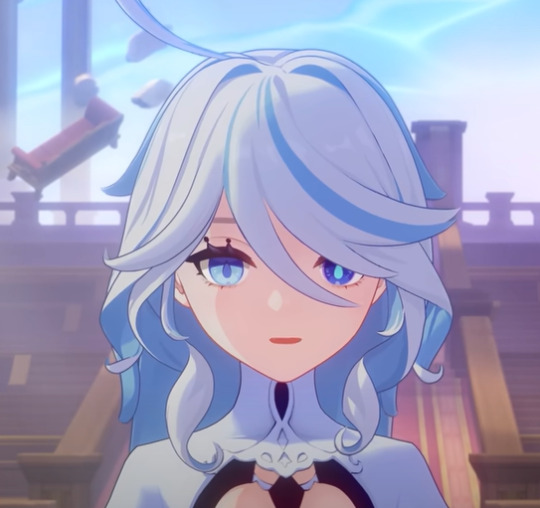
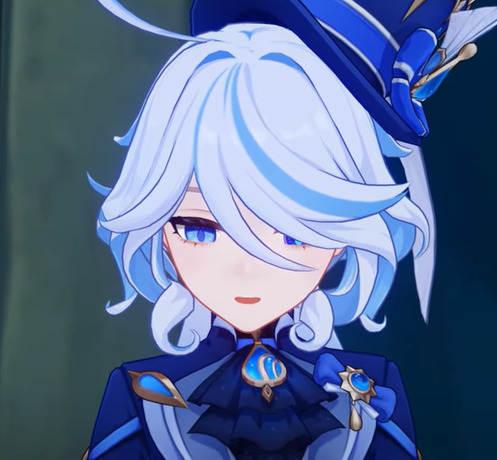
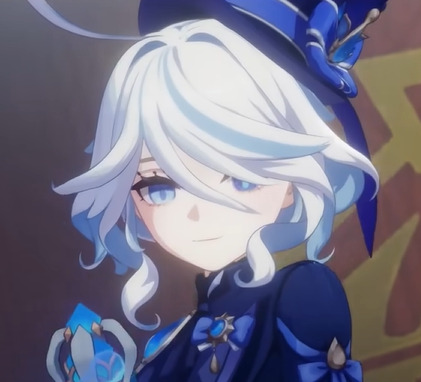
Focalors, whose hair is unnaturally split into two, might've been the forewarning of her two halves.
Focalors, and her humanity, are differentiated by the consequences of cutting their hair, of cutting their divinity.

Tag list :: @cxsinesis @luvielle
#coffee table discussions#genshin impact#genshin#furina#focalors#genshin furina#genshin focalors#fontaine#genshin fontaine#genshin archon#genshin analysis#genshin impact analysis#genshin thoughts#genshin impact furina#genshin impact focalors#genshin celestia#genshin impact celestia#genshin archon quest spoilers#archon quest#masquerade of the guilty#fontaine quest#4.2 genshin#4.2 spoilers#4.2 update#4.2 archon quest
71 notes
·
View notes
Text
the final cutscene in the 4.0 archon quest has some really interesting imagery from a meta perspective - it's framed very clearly like a performance on the main stage of the opera house:
tartaglia leaps on from his balcony to the opera house floor - he quite literally enters the stage from the wings like a character in a play, and then immediately begins a monologue. this could show his transition from audience to main character (in the context of the plot)

the ensuing fight all happens on the main stage of the opera, like a performance would, and is suitably dramatic. the enemies (gardemeks) also enter the main stage from the wings like in a play.
at several points during the cutscene, we see what is happening from the point of view of the audience, and it appears quite like watching a stageplay
furina's pov of the performance:

traveler & paimon's pov of the performance:
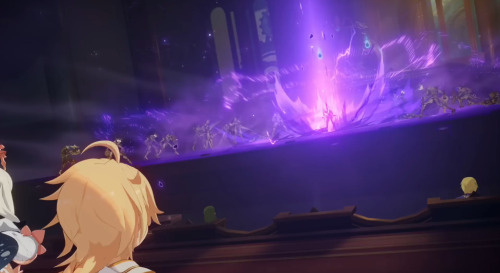
you can also see above that tartaglia's dramatic transformation happens when he's in the direct center of the stage, with the electro looking like a spotlight on him
in combination, all of this adds up to pretty clear imagery of a performance on the main stage
with the emphasis in fontaine on performances, and trials being likened to performances, this visual choice is either a really cool way of reinforcing that imagery, or a hint that this all was quite literally a performance
i wrote a theory (that this is pulled from) that investigates if something deeper's going on here. if you're interested, here's the link
regardless, this is some really cool thematic imagery (in addition to being a really cool fight scene)
#genshin impact#tartaglia#childe#genshin meta#genshin analysis#g:genshin#m:meta#*#it's all in the theory post but this deserved its own post#bc regardless if you accept the theory or think it's insane#this part holds up and is a really cool choice
144 notes
·
View notes